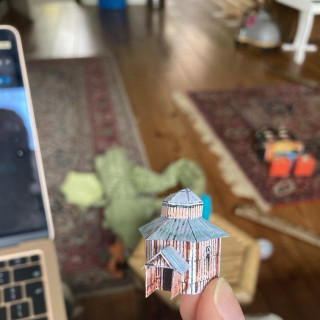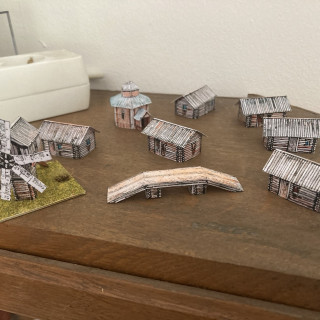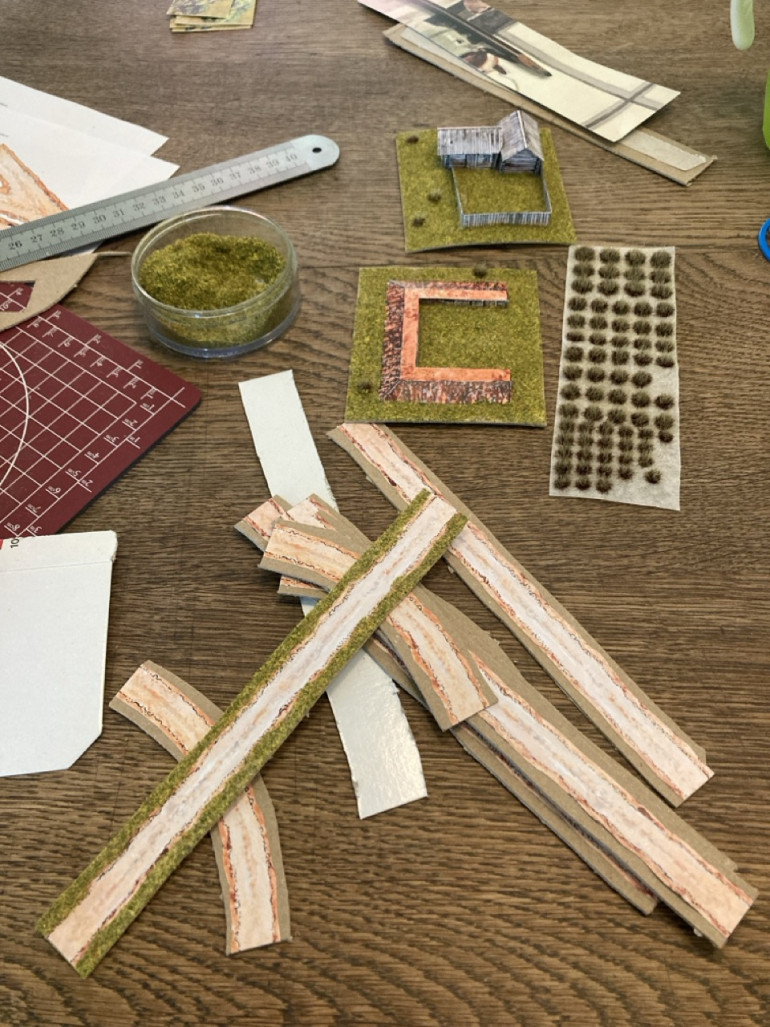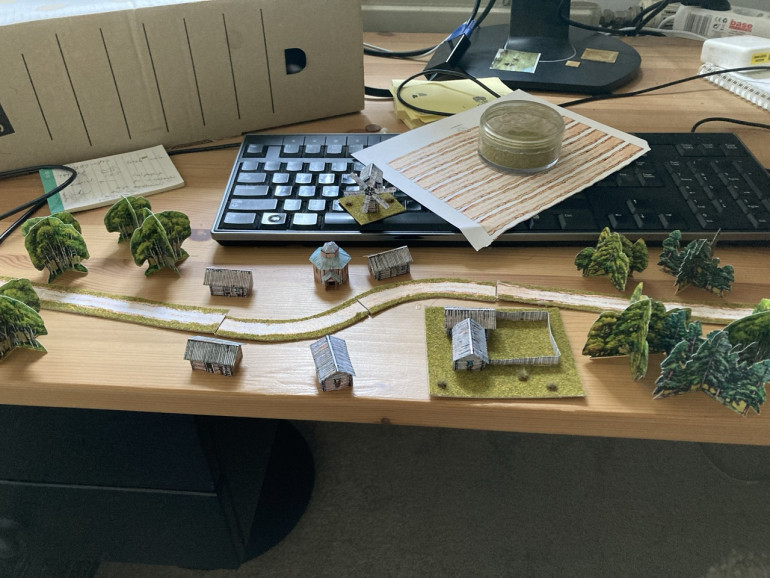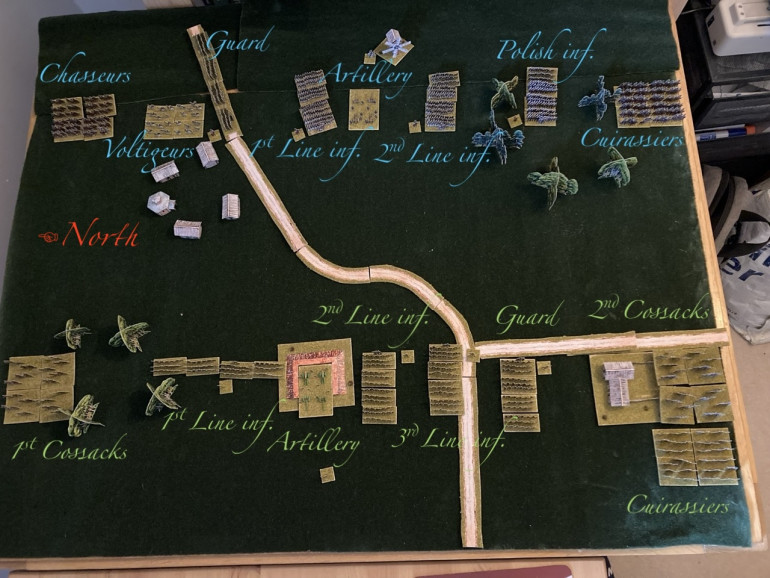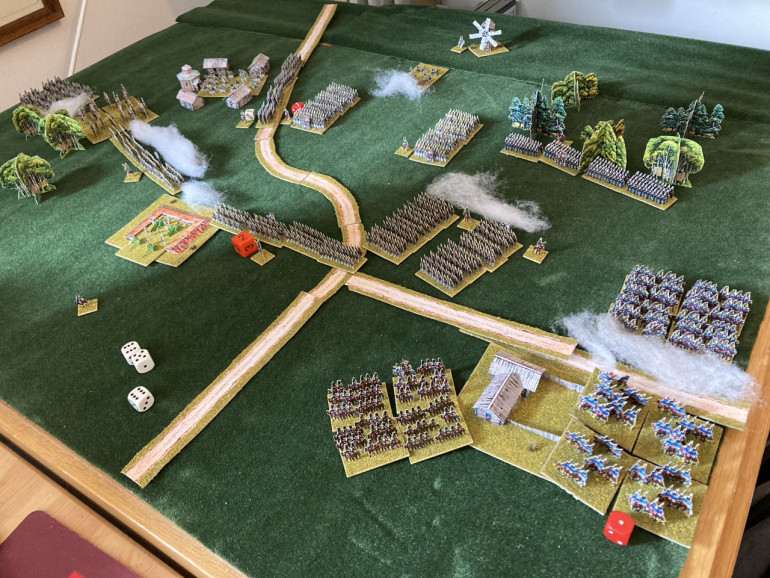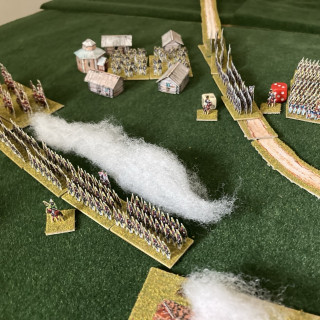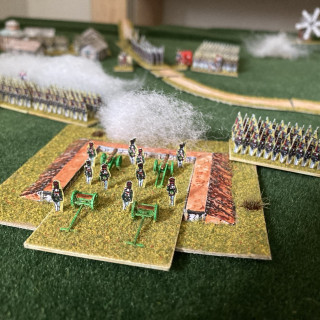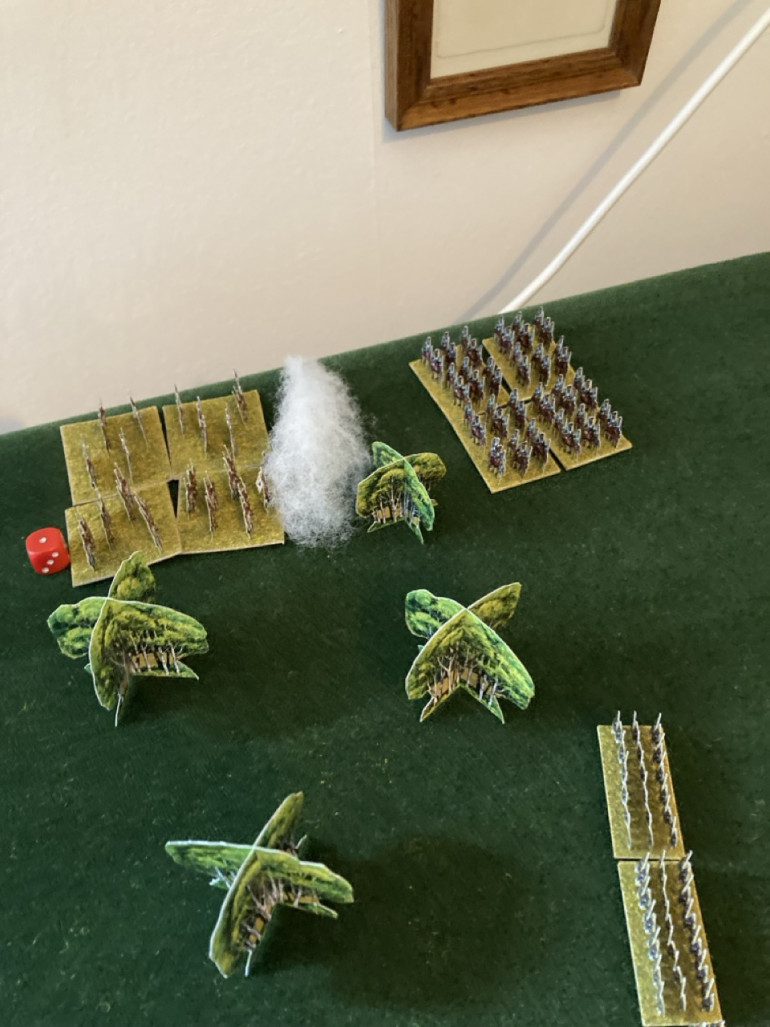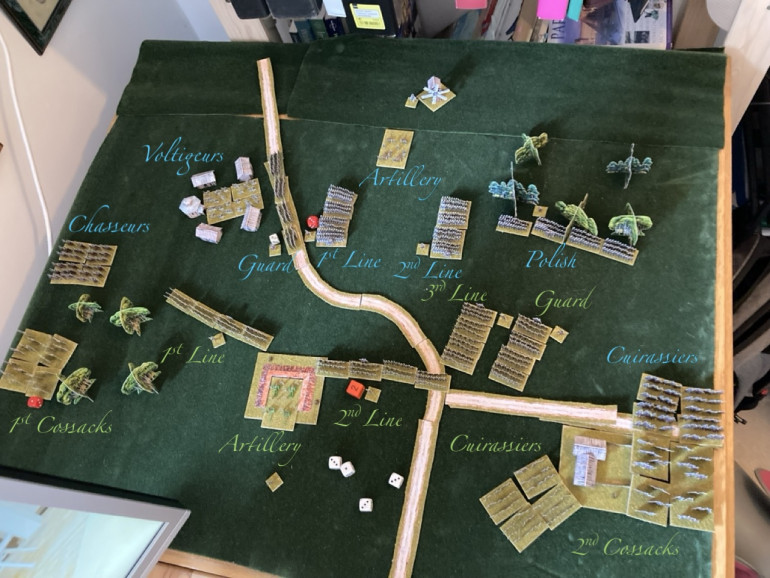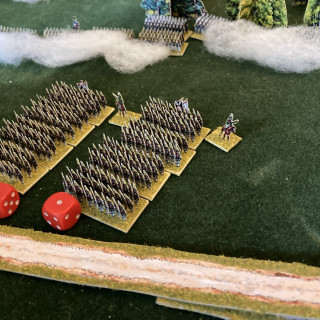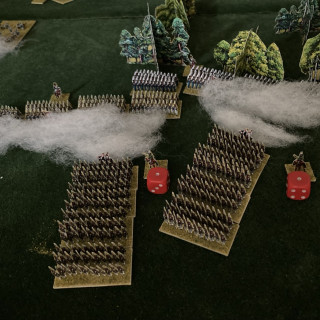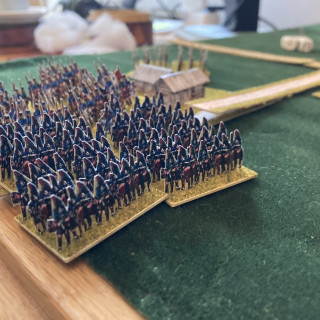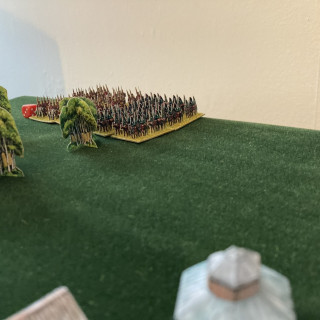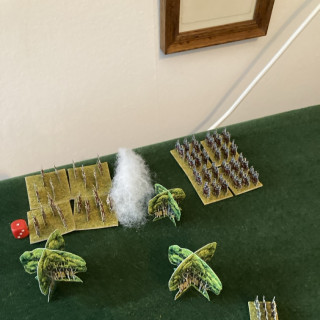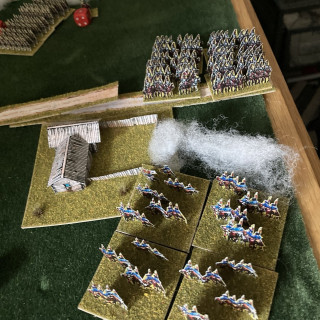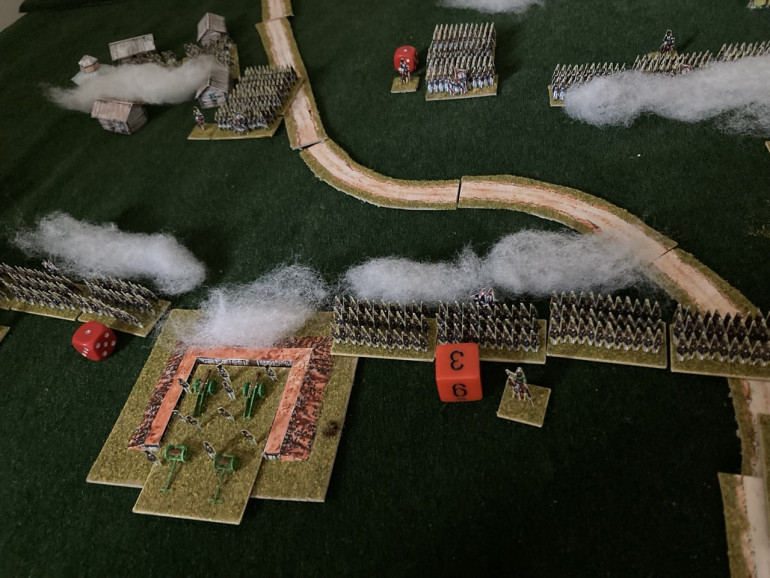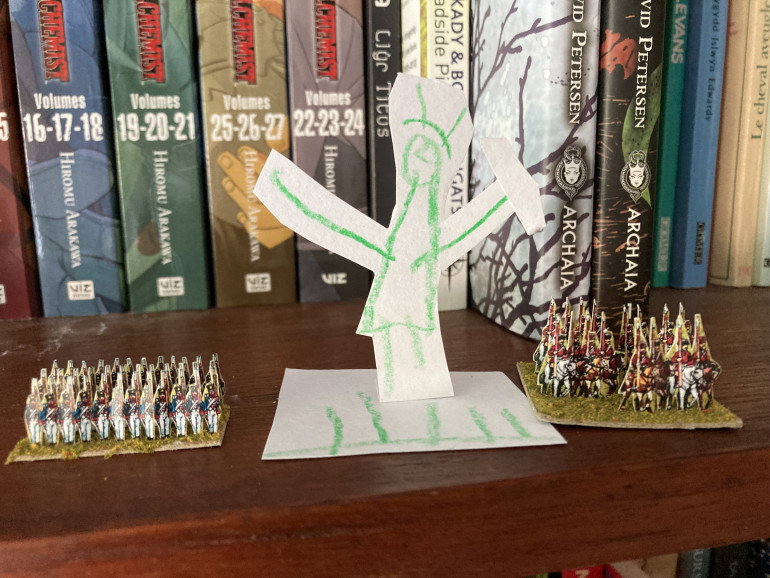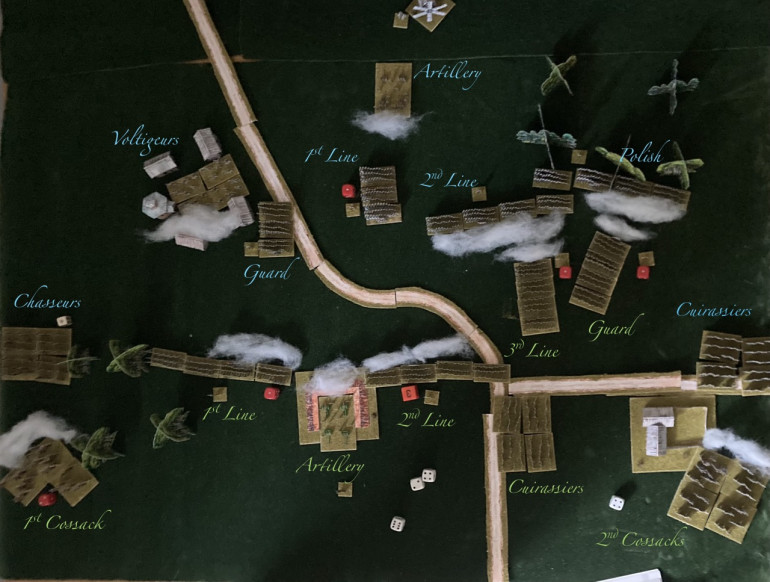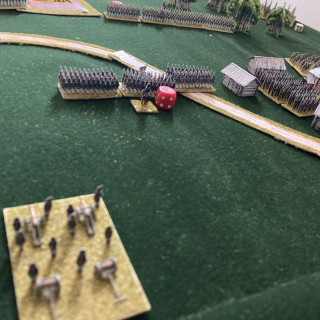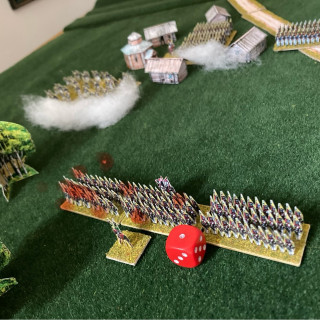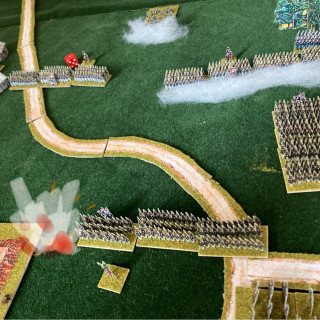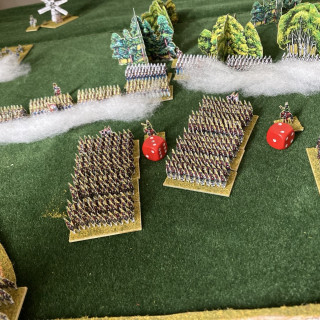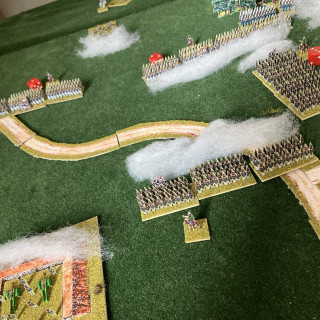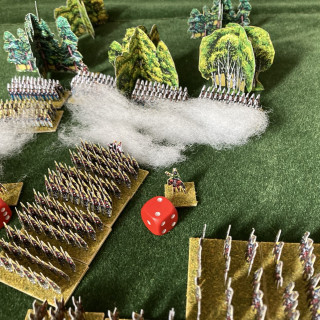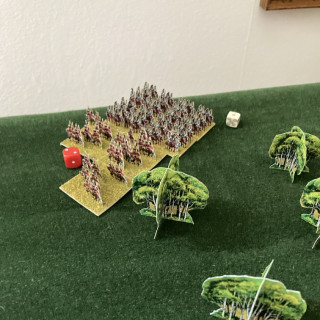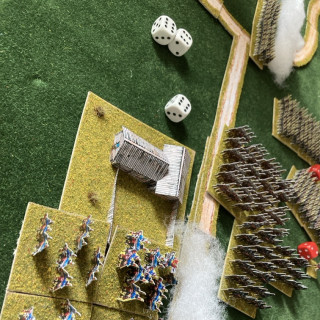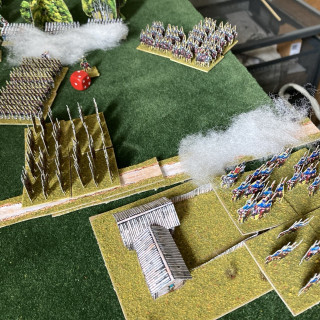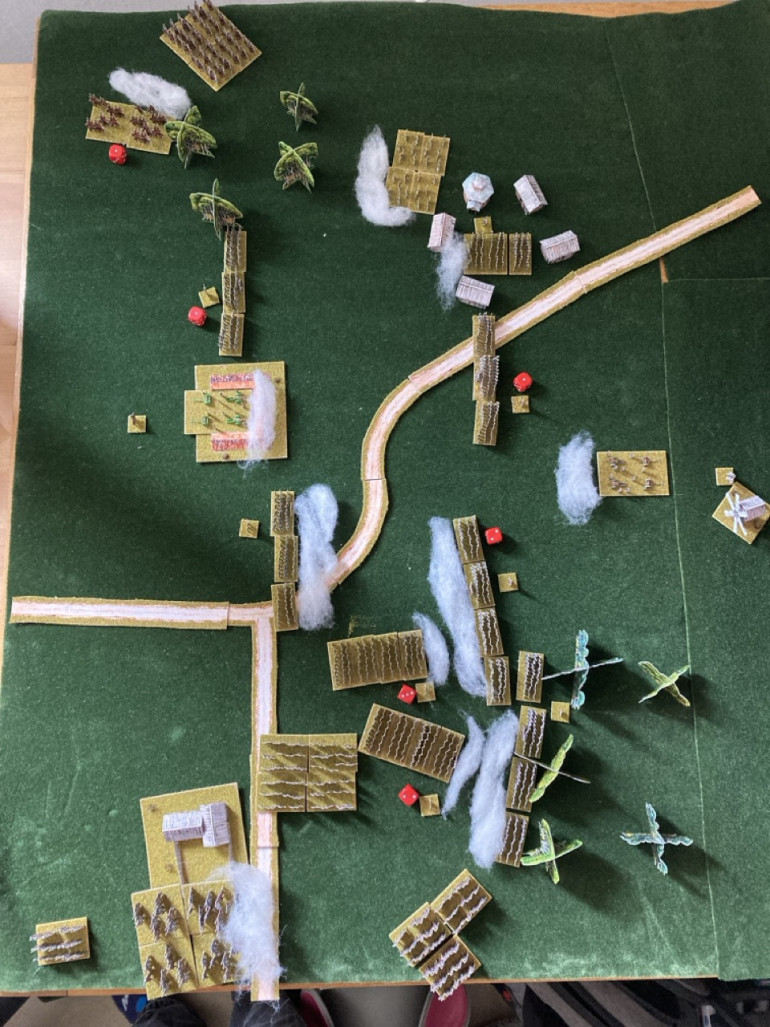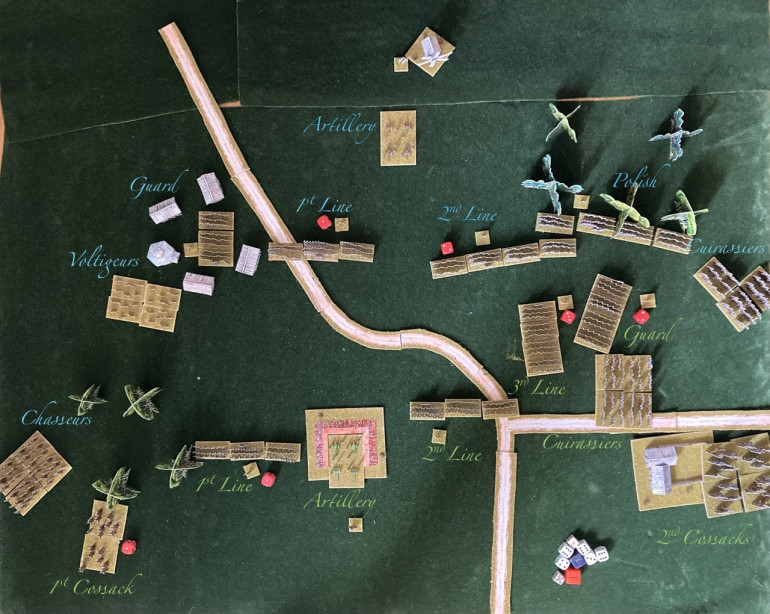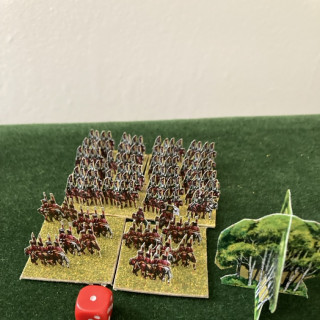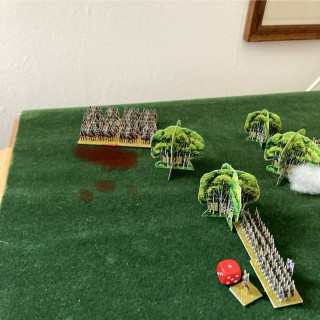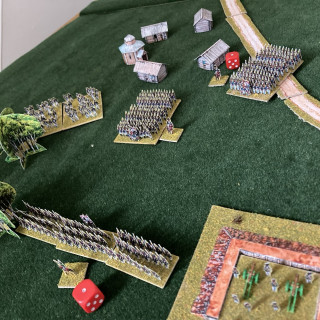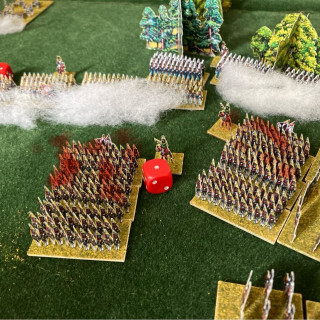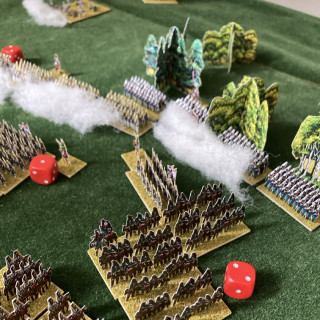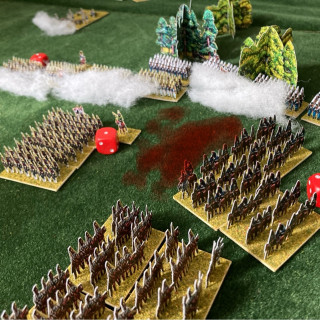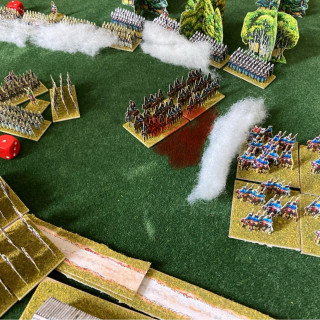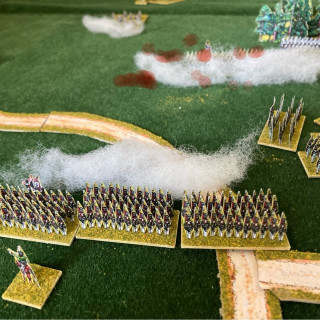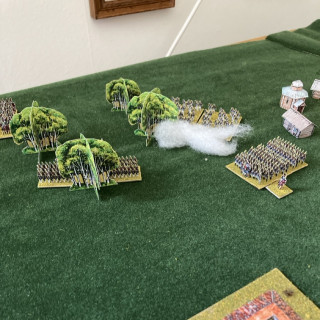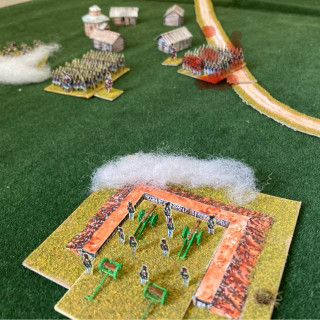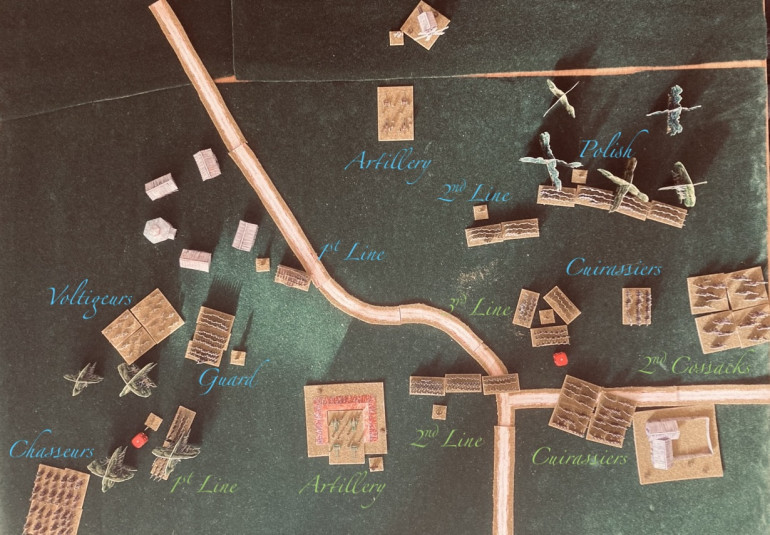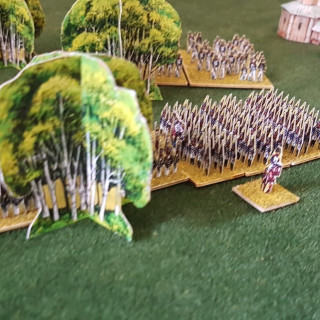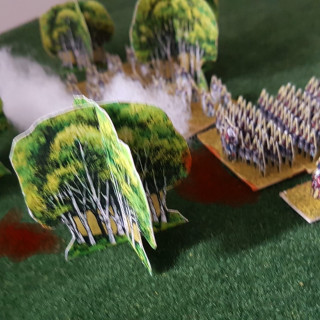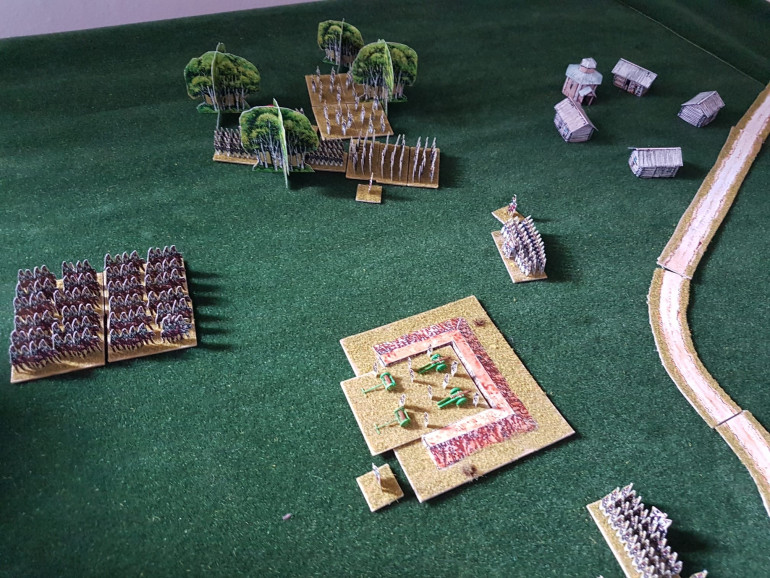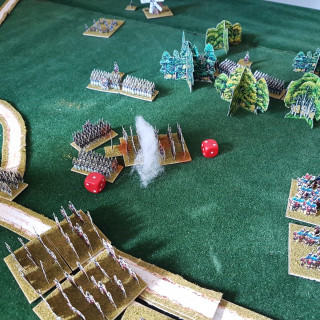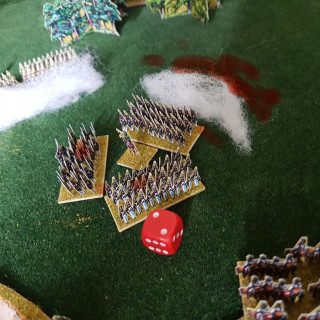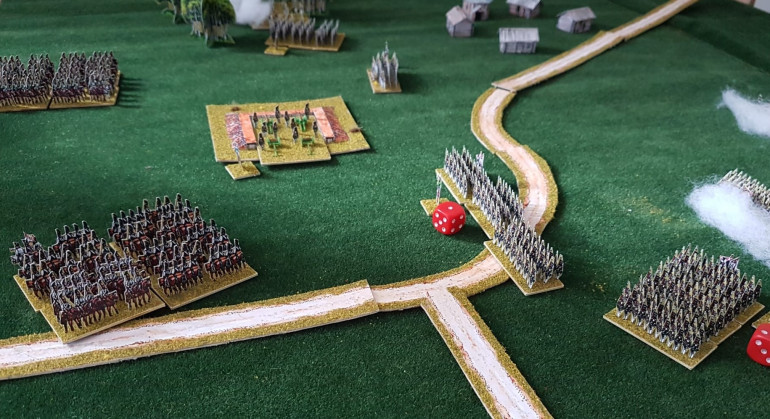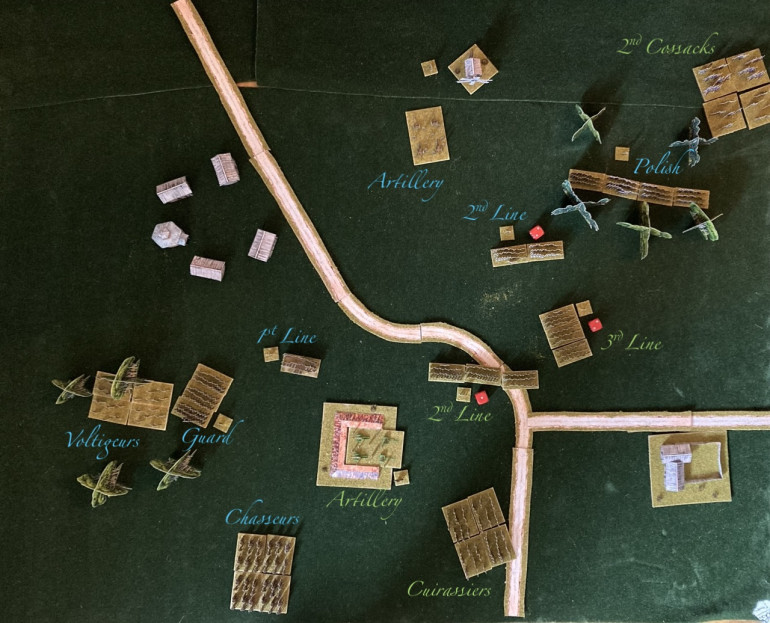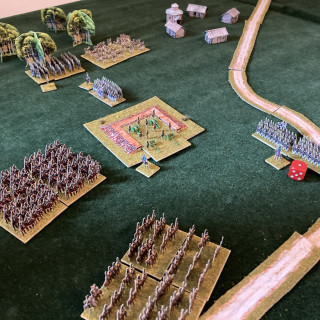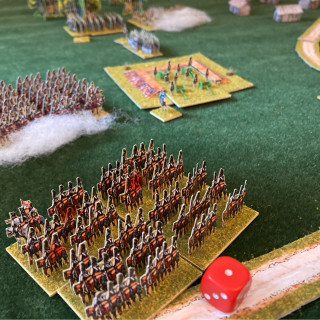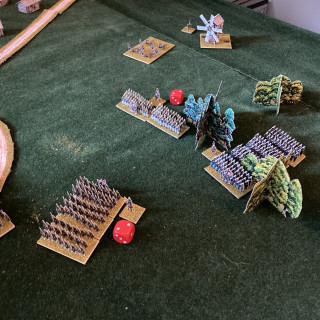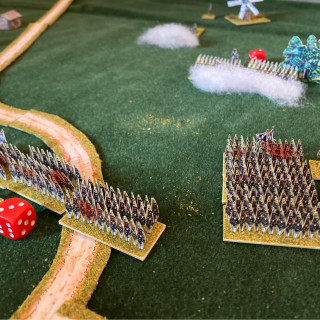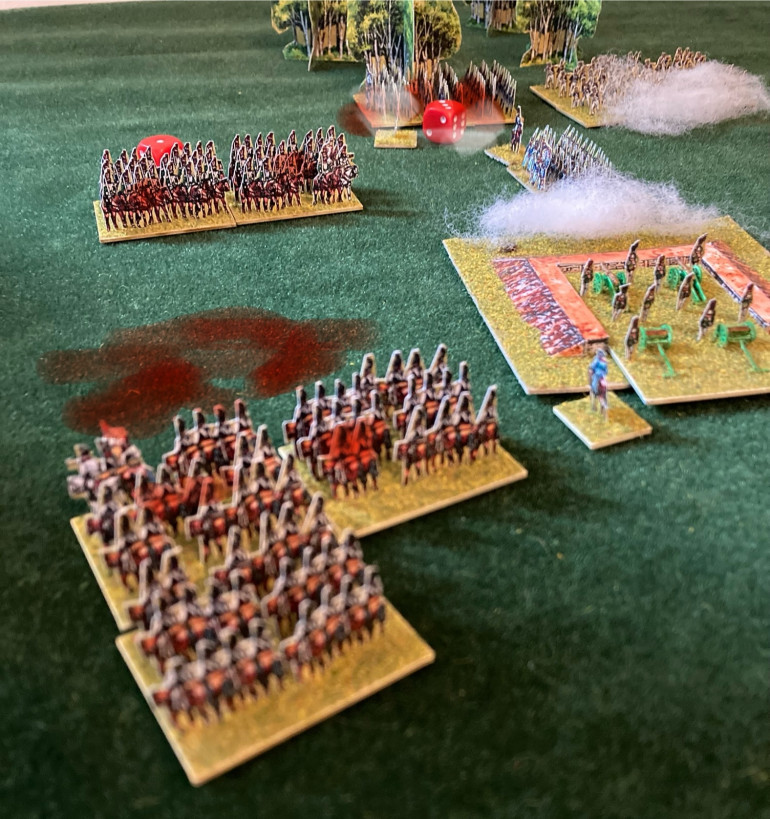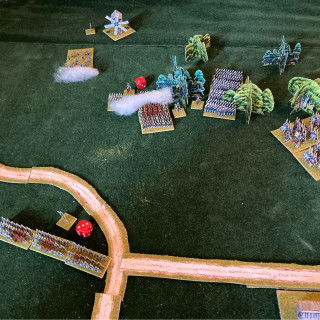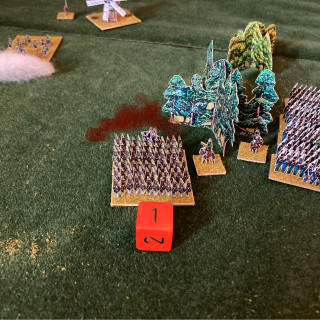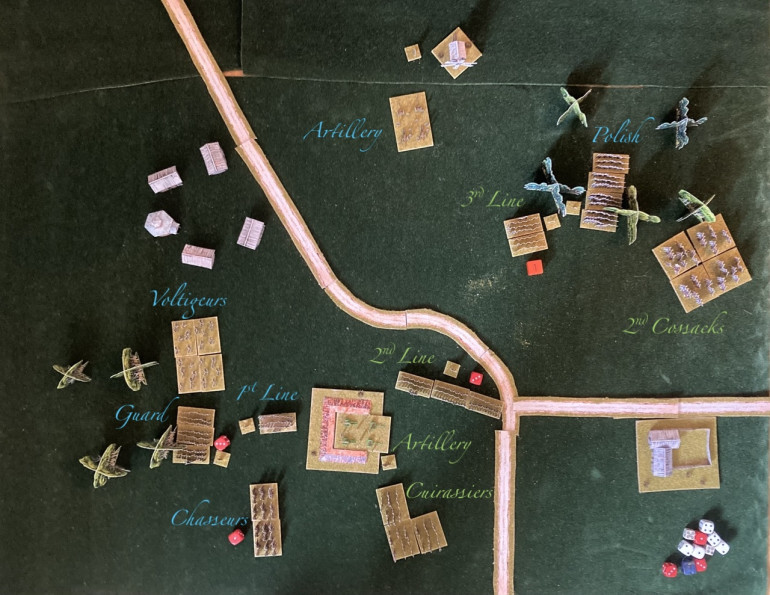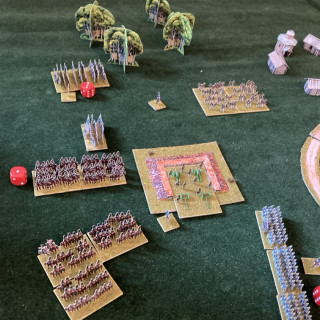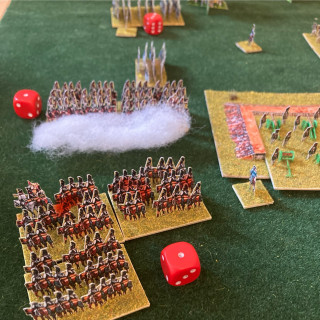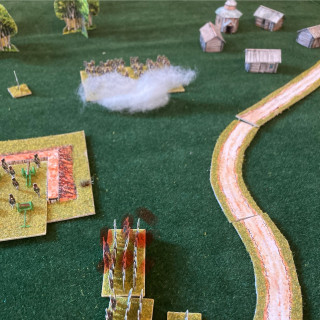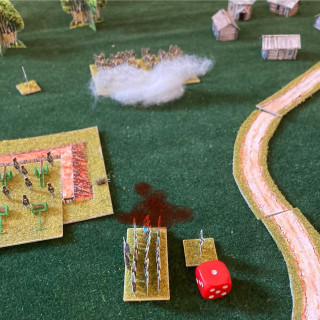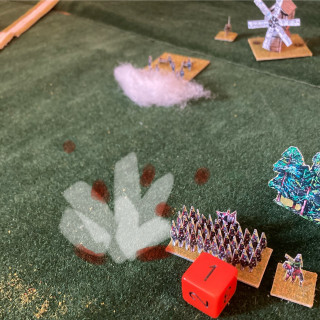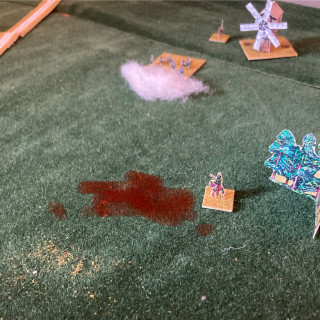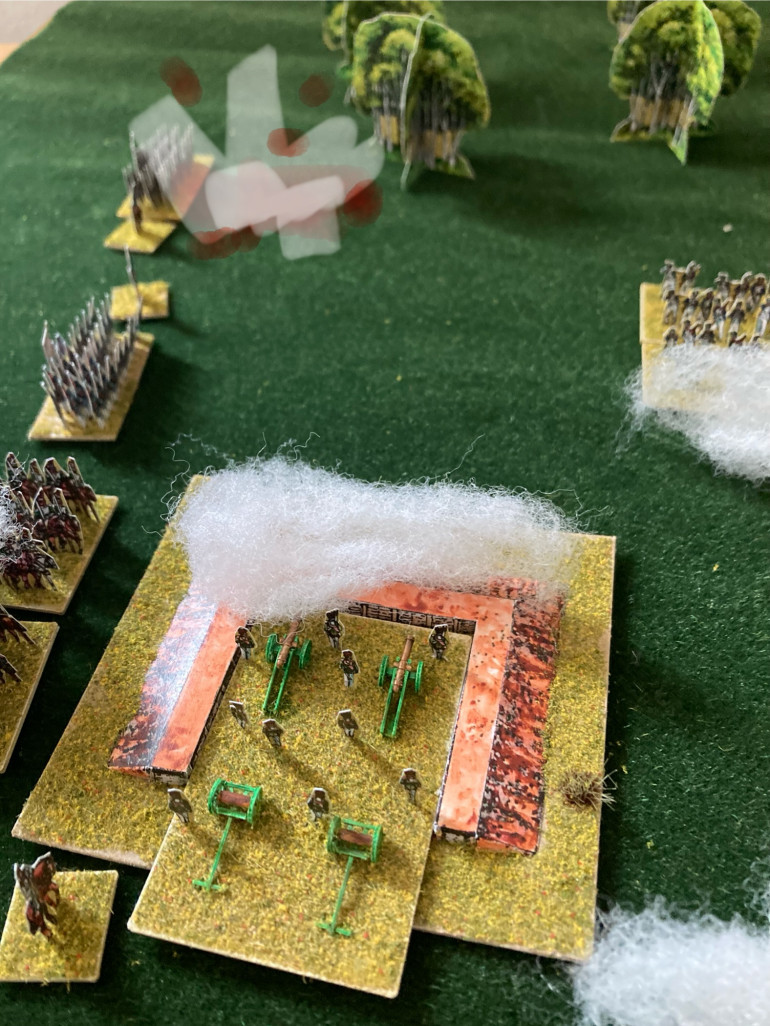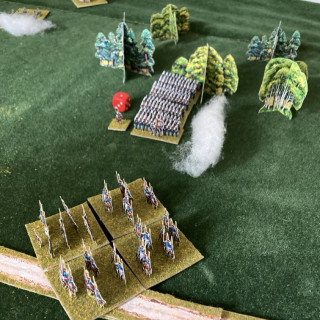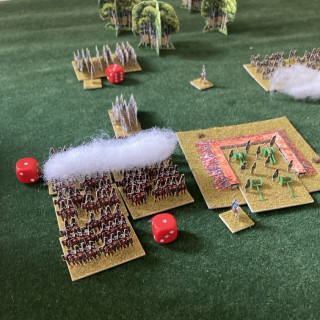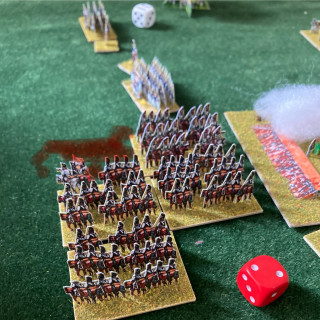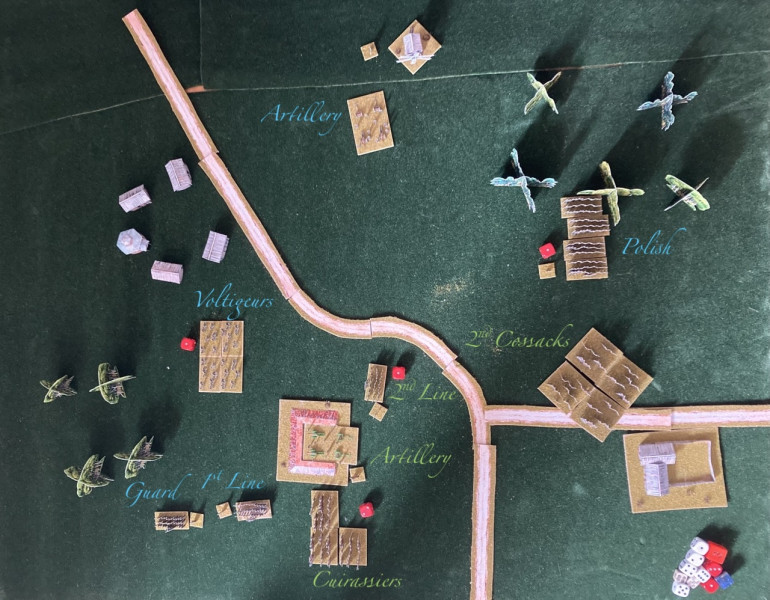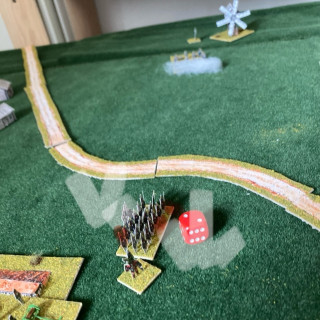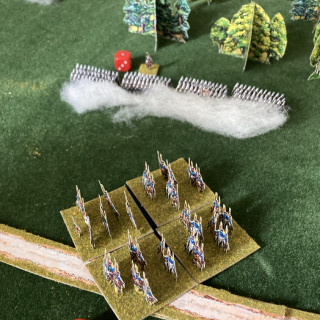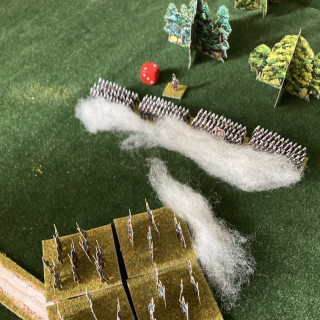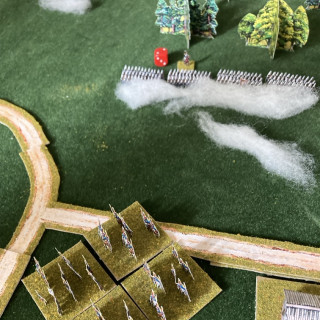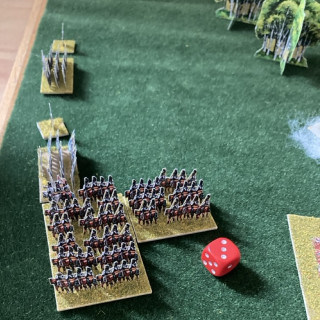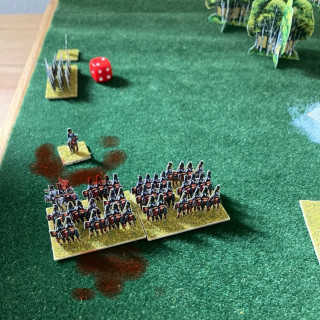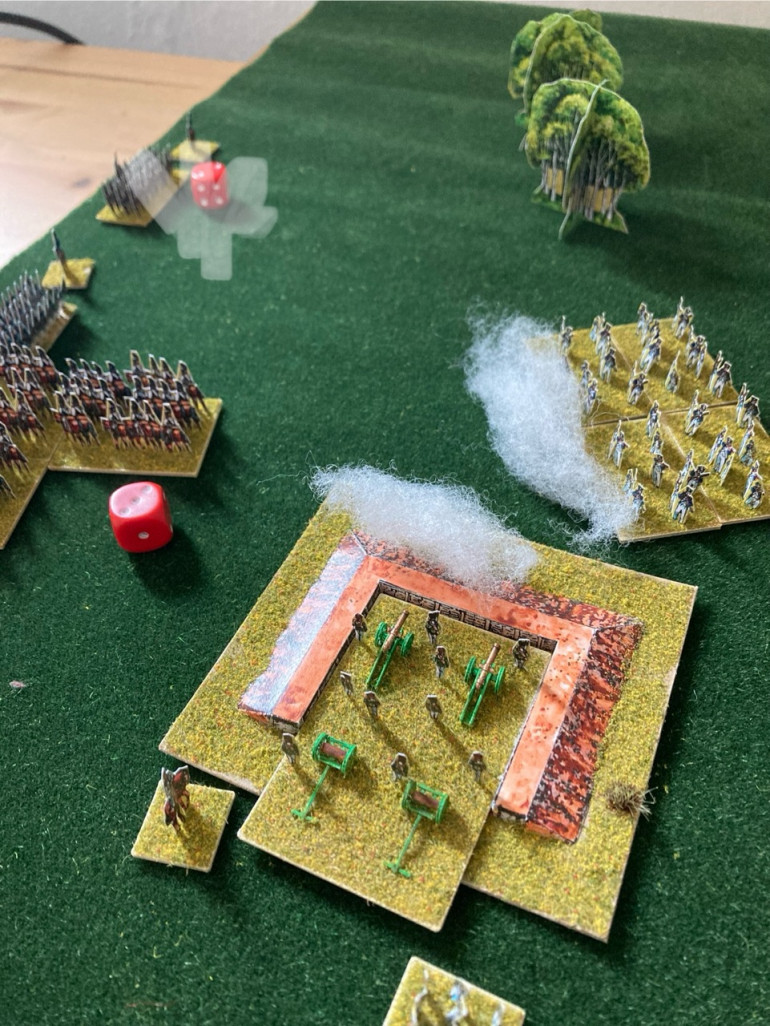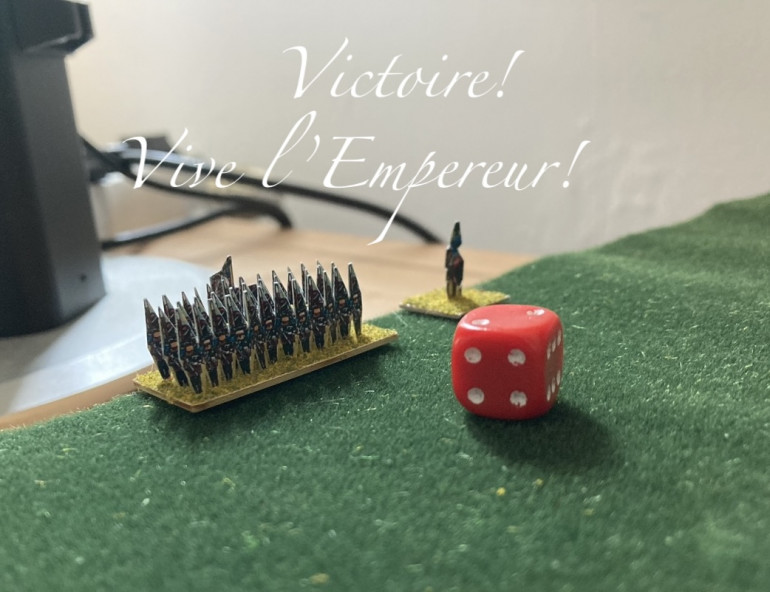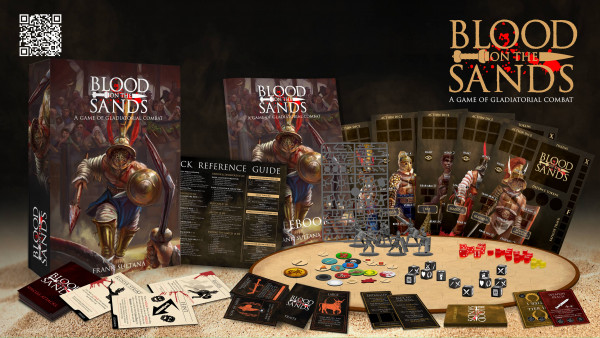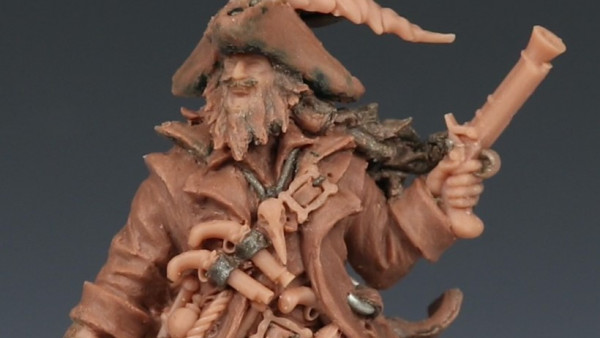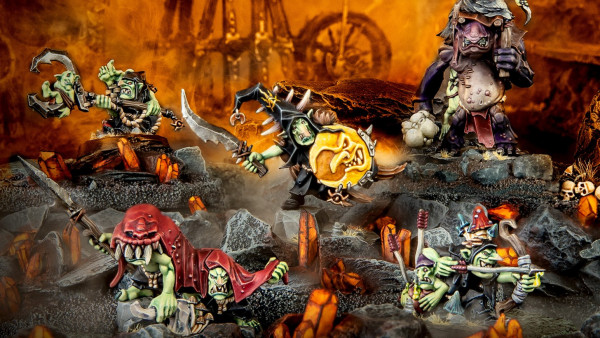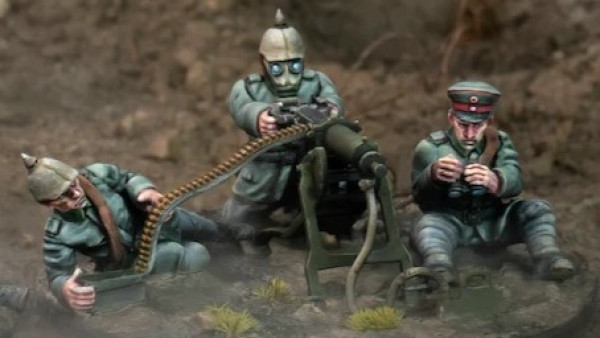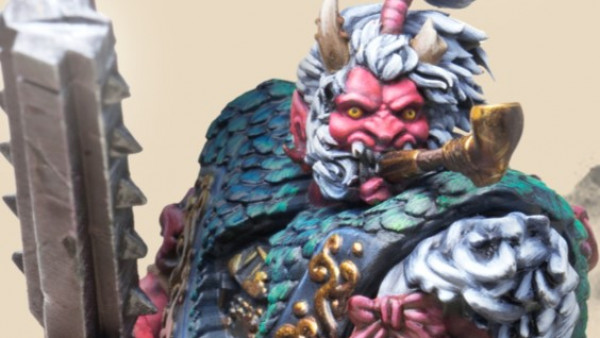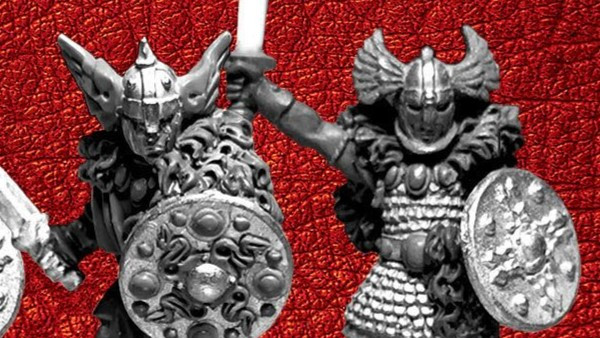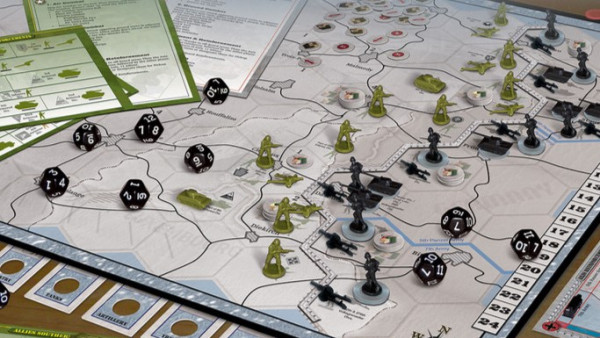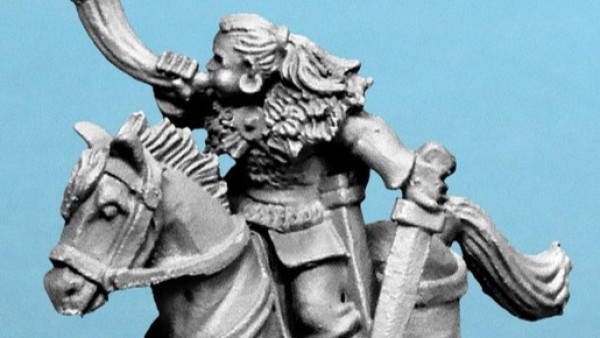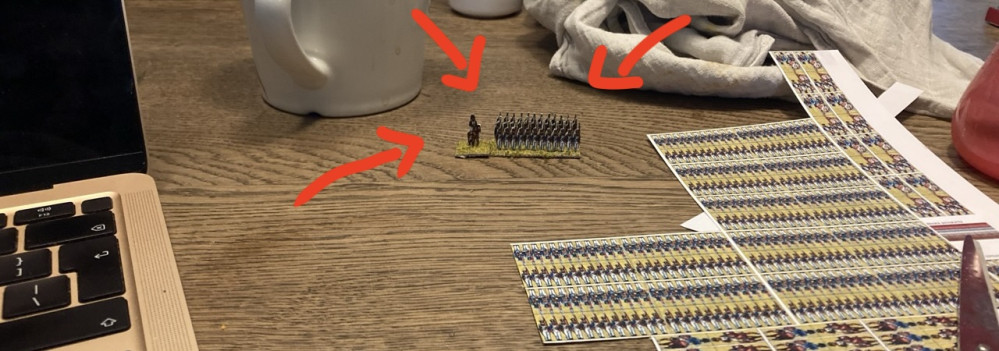
Dipping my toes into Napoleonics
Recommendations: 355
About the Project
So, I've had this itch for Napoleonics for a few years now. I think you guys are to blame for this. And Tolstoy. Him too. All the ingredients were there and now Ridley Scott has put the pan into the flames, meaning that I should probably start cooking something up.
Related Genre: Historical
This Project is Completed
First steps
One of the things that stopped me from committing to the Napoleonic itch until now, was that I couldn’t decide on a scale. To be honest, I am mostly drawn to 10mm, since that will give me a proper feeling for the battles of the era. But I also thought I should wait to see what scale others play in my area. Well, I haven’t found any others yet, but I’m done waiting!
Some might wonder why not get into it using a small-scale system like Silver Bayonet or Chosen Men: well, however cool they seem, I’m a bit tired of skirmish games. For a change I’d like to build a proper army again!
So, how to try out Napoleonics, but at a large scale? YES: paper miniatures! I got a set of Russian and French tiny fighting men plus some terrain from Peter’s Paper Boys, which is not only dirt cheap, but also seems easier than assembling and painting figurines.
Looking at the pages upon pages of printed out miniatures I get excited, although I do feel like a lion staring at a herd of zebras: my head slightly hurts as it tries to figure out where one mini starts and the other ends. There are so many of them, with the same markings!
Peter (I assume that is his actual name) from Peter’s Paper Boys has a video on his website giving you tips on how to cut and glue the minis. That was very helpful and gave me enough courage to do a test unit.
After having cut out the individual ranks, I lightly ran a hobby knife through the middle, which gives you a very neat fold. I glued the two sides together using pritt stick, which worked very well. After drying, this gave a strong and thick piece of paper.
Having started cutting out the tiny men I noticed two things:
- It is easiest to cut them out using scissors (as per Peter’s suggestion). The hobby knife felt like a good choice, but took much longer. And boy, this is going to take loooooooong.
- My hand hurts from cutting. This is going to take loooooooooooo<ouch>oooong.
At this point I should perhaps indicate what ruleset I intend to use.
Napoleonic Wargaming by Neil Thomas was brought to my attention in a podcast episode on Napoleonic wargaming. (For those interested, the podcast series is called The Napoleonicist and even though it normally doesn’t deal with wargaming, it makes for a very interesting listen!)
The book feels like a complete introduction into – well – Napoleonic wargaming. The first part gives you the historic background: basically, how was war fought before the Napoleonic wars, what changed, why were they fought and where, etc.
The author then goes into Napoleonic wargame rules, a brief history, the pitfalls and ultimately what a ruleset should be like. This is where he presents a ruleset of his own. Before giving you the ruleset itself, he first explains why he made certain choices in creating these rules. The man seems to know his stuff!
Now, since this is my first forage into Napoleonic wargaming (and historical wargaming in general!), I have no comparison to make. Keeping in mind the discussion in the recent XLBS episode, the rules do seem to reflect the period: your units can assume various formations: line, attack column, square, and marching column. There are no points to buy your units. Instead, you are allowed to pick 8 units and some are obligatory, depending on the period and the army. I find this somewhat curious, but we’ll see how that works out!
In general, the rules are kept simple and seem easy to understand. I will find this out when I start playing. I’ll dive into them more once I get to that stage!
Enough writy writes. Some more pictures!
So, instead of using the printed grass, I thought: why not just base the cardboard with flock? The above is an officer, which I used to test this. He is so tiny!!
I was quite pleased with how it worked out, so I set out to assemble the first base of French line infantry.
I’m very pleased with the look of these. I need three more bases to complete my first unit of line infantry. Note that the officer has no effect on the battle: he is just there to show marching direction when your unit assumes column of line formation (which means they seem to move sideways), to differentiate them from a normal line formation.
I’m not sure about the glue that I used for the flock. Normally I’d use wood glue, but since I was using ‘universal hobby glue’ to attach the paper guys to the base anyway, I figured I’d use it for the flock as well. The glue dried unevenly, which meant that some parts of the base were already drying and didn’t stick to the flock. This means that you see shiny bits of glue coming through at certain angles.
I think I’ll try to stick the paper men down with the universal glue and use it to flock the space between the ranks. I’ll then glue the flock around it using wood glue. I’ll keep you posted with the results!
Now, to continue cutting out more men…
Formations and more snippy snips!
So, I attached enough of the strips of infantry I had remaining from last snip session to three more bases to complete my first unit of French line infantry. I have to say, all those tiny fighting men lined op look amazing: that is the feeling I was looking for at this scale!
I mentioned last time I wasn’t too happy with how the universal glue adhered to the flock and glimmered through. So this time, I used the universal glue just for the center of the base: to attach the strips of infantry and to flock the area between them. I then used wood glue on the edges to get a good amount of flock there.
The idea was nice, but in practice it just became a bit messy. I used a brush to put the wood glue on, but also managed to scrape of the flock that was on there already…
I think that flock density now looks a bit better, but I’m not sure whether this amount of faff is really worth it. I might try wood glue only next!
Here is the same unit in the other formations (in addition to column above) that the rules from Napoleonic Wargaming allow, respectively: line (+ line Lloyd), square and column of route. About the column of route: I called it ‘column of line’ last time because I didn’t have to book close. Oops. However, like I mentioned last time, you can see that the officer indicates the direction in which the unit is moving.
Up next: cossacks!
Now, up next are some cossacks. I decided that I’m going to alternate between line infantry and other units, so that I’m not endlessly snipping shoulder-to-shoulder infantrymen.
The cossacks that Peter’s Paper Boys supplies are either in red or in blue. This confused me, since I’m an utter novice in Napoleonic uniforming. A question to the COG/OTTer hivemind supplied me with:
- A handy link about cossacks during the Napoleonic wars. This informed me that there was a Lifeguard Cossack Regiment, which apparently wore red and was considered an elite unit.
- The knowledge that Peter’s Paper Boys “work on the red versus blue army principle where units and duplicates are concerned. For larger battles yellow. White and green are sometimes added.” (@avernos).
Now, the rules in Napoleonic Wargaming do not differentiate between different kinds of cossacks, but I do like the idea of a bit of variation. I will therefore include one unit of red and one of blue.
About scissors
It has been pointed out to me in the Unofficial Hobby Hangout (UHH) that the pair of scissors I’ve been using is huge… So, I thought I’d talk a bit about scissors today! For this discussion I’ve made the following photo:
I started out using the smallest pair of scissors I’d found in our household, scissors nr. 2. Now, Peter from Peter’s Paper Boys did mention that one should get a pair of precision scissors. The video in which he said so didn’t have a clear image of them and, to be honest, I didn’t think to look up this up. I did know that scissors nr. 2 wasn’t going to cut it (…) in the long run, since after a hefty snipping session my hand would hurt and I lost feeling in my thumb (I guess a nerve got stuck or something).
So, on to scissors nr. 3! Now you may ask yourself what is special about them. Well, the label said that they were for precision cutting AND for left-handed fools like myself. I’ve never used left-handed scissors, so I thought that this might improve my snipping comfort. Well, it did to a degree. I never noticed that right-handed people using a regular pair of scissors don’t have to twist their hand to look on the outside where they’re cutting. What takes even more time to get used to, however, is that I unconsciously press the blades of the scissors in such a way that it gives you a finer cut. Or in the case of the left-handed pair, a sloppyer cut, since you push them away from each other.
After a bit I did get used to nr. 3, but to be honest, they actually seemed less precise than nr. 2! It was then that I stumbled across scissors nr. 4, while looking for something completely different. I had seen the UHH by now and thought to myself that these might actually be the scissors that @avernos was talking about. Now, these are actually more precise. I only have to watch out that I don’t close them completely, since that might rip a tiny bit of paper (which could be a tiny lance or rifle). I’m happy with these for now.
Now, why did I include scissors nr. 1 in the photo? Well, to point out that I actually could have used an even larger pair!
Cossacks!
With me being away for Christmas and New Year’s, I haven’t had much time to work on the paper boys. Today, however, I did find a moment to finish the first unit of cossacks!
With my shiny new precision scissors work progressed quickly. It is tempting to focus on cutting things out neatly, but with the amount of work I still have before me and the little time to do it, I keep reminding myself to keep it simple. You are going to notice very few details on this scale. And most of all: it is about the overall look!
Wood glue
I’ve been experimenting with glue for the base in an earlier entry:
- General purpose glue dried a bit too quickly and shone through the flock.
- General purpose glue for attaching the minis and wood glue for the flock around it was too much of a faff.
So this time I tried it with just wood glue.
I was pleasantly surprised with how well the paper boys stay in place on top of the wet glue. I was afraid they’d fall over, but if you bend them a bit beforehand (as suggested by Peter himself) there is no issue with that. Other than that it went exactly as expected:
- You get a thicker layer of flock.
- The cardboard base starts to bend a bit. Tsk!
Now, I think it’s not too bad with the bending and I’ll try to bend it back a bit once everything has dried. Let’s just hope it doesn’t get worse while I wait…
I really like the fulfillment I’m getting from working on these. The units are built very quickly (I’m just slow) and they look very pretty. I’m looking forward to the next unit of infantry!
Snippathon '24
To create one unit of French line infantry, it takes a minimum of 480 snips, the way I’m doing it: 40 snips per line, times 3 per base times 4 bases is 480 snips for a unit, excluding those for the standard bearer, musician and commander. I’m not terribly interested in the Peninsular Campaign, but I do envy British players, who only have to make two lines per base… These half thousand snips did allow me to finish my second French unit!
Blue cossacks and light satellites
As promised previously I now went with the cossacks in blue. More or less in tandem, I worked on the third line unit for the French army: the so-called satellite infantry. By this the client states of the French are meant, e.g. the Duchy of Warsaw, Naples, various German states (not the Kingdom of Holland though; we were there, but by then annexed into France). I will discuss the army composition I’m going for in a future post, but for now it suffices that this is an obligatory choice in the French army for the 1812 invasion into Russia.
To differentiate these from the regular French line infantry, I chose the Light infantry, because Peter’s Paper Boys didn’t printout sheet for these specifically. In hindsight, I should perhaps have chosen the infantry in greatcoats, which may have been more historically accurate, but I’m going to cut myself some slack, since I’m just getting into this.
I think it is a bit of a pity that the background for the top half of the light infantry lines is white, rather than the green of the line infantry. This wouldn’t be a problem if I didn’t cut corners (well, I cut fewer of those), but it does make them more recognisable on the table.
I did run into a previously encountered problem, however. Do you remember the cossacks on hills? The cardboard base started bending because of the wet wood glue. In case of the cossacks, it bent front to back, meaning that it had no effect on the cossacks. I hadn’t noticed this with the second unit of line infantry, but the bend was very obvious with the light/satellite infantry and goes from side to side!
This means that some of the men seem to be taking off!
While in civil service I learned that “most problems, if left long enough, will fix themselves”, and this has proven true once again. In fact, the aforementioned cossacks that were afflicted by the same problem came to stand on flat bases again in the end as well.
And here are some images of the cossacks being fine.
Hurrah! Golden Button!
Tiny update to celebrate the golden button! Very happy with this and a great motivator to continue the project. Big thanks to the OTT community for both the inspiration and the advice! To celebrate this I thought I’d share a few pictures of all the units I’ve assembled up to now.
And finally, the paperboys in action: the French infantry forms into squares as the cossacks have surprised them from the rear!
More about bases
Oof, it’s been some itme since last update. It’d be unfair to blame it all on work being busy lately. As many may recognise, it is difficult to focus on one project. I’ve been planning a new Kill Team and … I’ve bought an FDM printer. So I’ve been messing about printing small terrain pieces and mainly tiny tanks for a ‘real life’ version of the classic GBA game Advance Wars. Now I’ve got the initial novelty of the thing out of my system, I noticed that I should get back to my paper Napoleonics.
Call me lazy, but I found cutting out the bases for the units from cardboard a boring chore. On top of that, the issue with the board bending after being applied with wood glue was still nagging on me. So, I though’t I’d use my 3D printer to fix this issue!
Behold! Technically I designed these myself, but the work was so minimal that it cannot be called ‘design’ really. They are just 1mm high blocks with the right dimension with ever so slightly rounded corners. They print really fast and are churned out at the press of a button!
With my filament being dark green I thought it’d be even more awesome, until I noticed that the dark green border stands out too much when fielded next to the cardboard bases. Also, the dark green really gives the flock on top a darker hue. I am ashamed to say that I proceeded to the perverse art of trying to make the plastic look like cardboard…
This was easier to achieve than I thought, just a brainmatter beige base coat followed up with a sepia wash. All in all, still easier than cutting out the cardboard bases myself.
In the photos above you can see the unpainted and painted plastic bases in the first two, which you can compare to an old photo of my units on coardboard bases.
Not unimportant: the soldiers that got the first set of new bases are the French Grenadiers! Vive l’Empereur!
Cuirassiers and army lists
Another small update! I’ve cut and based the Russian cuirassiers, which is the last unit of Russian cavalry. Whereas I’ve only been working with irregular cavalry until now (the cossacks), these are regular, which means I ranked them up.
I’m not sure why, but a few of the cuirassiers fell over when I tried to glue them in place. I can’t remember this problem from the cossacks, so maybe I didn’t bend them as much? Or perhaps this is a difference between the old cardboard bases and the new plastic bases? That said, I find that the flock sticks better to the plastic bases. All in all, I’m very pleased with how these turned out.
About armylists
As a bonus, I’ll talk about the armies I’m assembling. Napoleonic Wargaming has a lot of different possible different army lists to pick from, especially for the French.
I may have mentioned it before, but there are no points in the rules laid out in Napoleonic Wargaming. Instead, you get to pick 8 units from a small collection of choices. The player may be allowed to pick up to 1 unit only for some rarer units, and has to pick a minimum of 2 in some units that are typical for the army (often types of line infantry). These unit types may be similar between armies, but the difference is then often in the training and/or experience of the unit, which varies from ‘levy’ up to ‘elite’ (e.g. French conscripts vs Old Guard Grenadiers), the formations they may assume and the number of lines they deploy in (2 or 3). Interestingly, all armies are allowed only 0-1 artillery unit, where the French and Russians have the best, and the Ottomans the worst. The aforementioned Old Style armies are considered more trained and professional and therefore smaller, which means that a player of those armies can only field up to 6 units.
For the French I went with the Grande Armée. For the Russians there is just the generic Old Style army, which is used for all early opponents of the French republic, or the later Russian army, which has the option to add Jaegers from 1812 onwards. I went with the later Russian army, but without the Jaegers.
In addition to these numbers there each list also has some special rules, which lend more flavour to it, for example in the case of the Russians there are rules for sluggish infantry and stubborn infantry.
To be honest, since this is my first taste of Napoleonic wargaming I wasn’t too sure what I was doing and just went the lists below. I felt that both needed artillery, since I cannot imagine a Napoleonic battle without!
French Army
- 2 Line infantry
- 1 Satellite infantry (Duchy of Warsaw)
- 1 Voltigeurs
- 1 Imperial guard
- 1 Cuirassiers
- 1 Chasseurs à cheval
- 1 Artillery
Russian army
- 3 Line infantry
- 1 Guard infantry
- 1 Cuirassiers
- 2 Cossacks
- 1 Artillery
Of these lists I have now built all the French line infantry and all the Russian cavalry. This technically means I am halfway through!
In the photo below you can see the size of one army (which consists in this case of French infantry and Russian cavalry), minus the artillery. I have to say that the paper boys do have a grand effect when lined up like this!
The cannon are [sic]!
Reading into Napoleonics I’ve learned that ‘cannon’ as a plural is a thing and that using it makes you just better than the others, har har har <sips tea with pinky in the air>. So, there is the joke in the title. With that out of the way, I would like to cycle back to a handy comment all the way back to my first entry in this project.
Back then I still optimistically replied that I wanted to try to build the 3D paper ones, where you have to fold the cut out gun barrel around a pin. The longer I thought on it, the more I came to the realisation that using a actual tiny cannon model might indeed be preferable.
Rather than riding out this wave of reason, I jumped on top of the shark and tried surfing onto the wave of 3D printing. Oh, not the still somewhat reasonable wave of resin printing. Oh noooo <waves hand and spills tea from cup>. The wave of FDM printing with a 0.2 nozzle.
So, I sat down, and looked up a chunky design on Thingiverse of which I felt that it could handle the scaling down to 10mm wargaming.
The scaling down went okay…? The spokes of the wheels disappeared at this size, so I made some new wheels myself in TinkerCad. Also, I had to fill up the cannon barrel to avoid a hole appearing in it. Lo and behold!
To assemble it, I slightly widened the holes in the wheels, so they connected snugly to the gun carriage. I also found that the rounded bottom side of the gun carriage came out a bit ugly, so I straightened that out in TinkerCad as well. This gave me a design that I felt could be repeated!
Limbers
Looking at the paper cut out model of the canon I noticed that Peter also supplied you with limbers. Now, I didn’t immediately find any (free) limbers designs that either scaled down well or matched my cannon, so I thought: maybe I can design one myself! I have to apologise to any specialists in the field. I just looked at these two pictures I found with DuckDuckGo and let myself get inspired to create something.
As you can see I just reused the wheels I’d created earlier. Once printed out, I found myself with the smallest lawn mower, which just happens to be perfect for mowing flock!
Together with the cannons, I found it worked well. The cannon (!) and the limbers did not fit very well on the base size suggested in Napoleonic Wargaming by Neil Thomas, which is 40mm x 40mm. I wasn’t going to give up my limbers though and just decided to increase the base size to 30mm x 60mm.
I’m quite happy with the end result and decided to bring my two bases of cannon out into the sun for a photoshoot. Coming soon to theaters near you: Honey, I shrunk the artillery devision!
Some paper terrain
To be honest, I’m in a bit of a hobby rut at the moment. I’m not pleased with anything that I’ve tried to paint recently and I feel that I’ve only gotten worse at it over the last years. The paper hobby has been a lovely way for me to engage with the hobby in a positive way: it is really cool to see how quick you can build something!
Having finished the armies themselves, I felt that I could not be motivated to build any of the paper terrain that I had also bought. Turned out that I’m capable of surprising myself as I’ve done exactly that.
I haven’t taken pictures of all the steps, but I can tell you that it came with its own challenges. The trees were like the paper soldiers I’ve been making until now, the only difference being that they did not need attaching to a base, but are slotted together.The buildings on the other hand needed some folding and gluing on a tiny scale, leading to some curses and me finding myself stuck to the couch.
Note that the bridge has no river yet to accompany it, but I have cut out the roads. The simplest way to make them would have been to just cut them out and be done with it. I expect, however, that the separate segments would then start moving around when moving troops along it. I therefore decided to add some heft by gluing the roads to cardboard and cutting that out with about half a centimeter margin on each side, which I then flocked.
Below is a photo of almost all of it togerther. I notice that I forgot to include the redan in this picture. You can see it in the above photo of the roads being made, however.
Battle report: The Battle of Derevushka, round 1
With the assembly of the armies and terrain done I thought I’d give the wargaming rules laid out in Napoleonic Wargaming a go. I’ve set up a small gaming table next to my home desk (not dangerous at all…) and the idea is to do a game against myself during any breaks from work or parenting. This may take some time, but that is fine by me. As the battle progresses I strive to give you updates in the form a battle report. Luckily I had an afternoon to myself yesterday, which meant I could really take my time setting up and slowly getting used to the rules.
Because of the constraints of the project system I will strive to do a round in each update.
In a previous post I gave you my intended army lists. Here they are again, so you won’t have to scroll to and fro. Note that I haven’t given them any fancy names as the regiments normally have. I might do that for future battles though 🙂
French Army
- 2 Line infantry (1st and 2nd regiment)
- 1 Satellite infantry (Duchy of Warsaw)
- 1 Voltigeurs (= skirmish unit)
- 1 Imperial guard
- 1 Cuirassiers (heavy cavalry)
- 1 Chasseurs à cheval (medium cavalry)
- 1 Artillery
Russian army
- 3 Line infantry (1st, 2nd and 3rd regiment)
- 1 Guard infantry
- 1 Cuirassiers (heavy cavalry)
- 2 Cossacks (tribal/irregular cavalry)
- 1 Artillery
The Battle of Derevushka
In the early days of the French invasion of Russia a small battle took place that has been all but forgotton: the Battle of Derevushka. As Napoleon’s forces rapidly marched across the vast plains of Russia, they met only sparing resistance. It is not known whether the Russians were to slow in their retreat or whether an eager officer decided that he would single-handedly show that the French troops could only break against the wall of Russian stubborness. The forces met outside the hamlet of Derevushka, however, and both sides were led by inexperienced officers (me and me).
[I’ll give you a brief description of the battlefield as it is outlined above. On the Northern side you have the hamlet Derevushka, which found itself the site of this battle unfortunately. Slightly to its North-West and to the South there are small wooded areas. These (and the hamlet) can only be entered by infantry. The roads can only be used effectively by infantry in column of route, which allows them to move at a higher pace. Other than that there is a farm in the South-Western corner, which can also be occupied by infantry alone. The redan on the Russian side is purely cosmetic in this battle. I put it there because I had it and I liked it.]
The French advance, the Russians answer
︎As was expected, the French side took the initiative and advanced quickly with its line infantry. Only the Polish satellite infantry was instructed to hold their ground, so they deployed into line across the border of the woods. The French voltigeurs rushed towards Derevushka itself and entrenched themselves there. On the flanks, the French cavalry shot forward to leave the nimble Russian cossacks no room to maneuvre. The chasseurs à cheval on the North peppered their opponents with ineffective carbine fire, which only slightly wounded the tribesmen. The French artillery that had conquered Europe, roared across the battlefied and fired round shot into the Russian 2nd line infantry regiment, wounding several, but unable to stop their lumbering advance.
The Russians responded by deploying the 2nd Line infantry regiment, that had just been hit by artillery fire, to line formation. This way they hoped to create an effective way to whittle down the advance of the French infantry in the centre. On the South flank, two units of line infantry, including the Guard, advanced towards the Polish line in attack columns. The Russian 1st Line infantry regiment opened fire, but was only able to wound some of the French Imperial Guard advancing along the road. The grapeshot fired by the Russian artillery at the French attack column in front of it was slightly more effective, but failed to stem their approach.
The cossacks, having been caught off guard by the enemy cavalry, hastily fired a volley of their own, but didn’t managed to hit anything. On the South flank the Russian cuirassiers now had to maneuver around the cossack rabble, very much to the chagrin of their officer.
Battle report: The Battle of Derevushka, round 2
The French army pressed onwards into the hail of Russian fire and deployed their Guard infantry, who had been marching in column of route along the road, to an attack column. Thus they hoped to reinforce the 1st Line infantry regiment, who had been taking a dangerous amount of cannon fire. The 2nd Line Infantry deployed to line, hoping to pepper the approaching Russian attack columns with enough fire to discourage them in their steady advance. They let loose a volley with support from the Polish sattelite regiment, but barely hit the Russian 3rd Line infantry regiment and Guard regiment, who kept advancing, while loosing an ineffective volley of their own.
On the flanks the French cavalry again charged the opposing cossacks. The cuirassiers, while being able to drive the Russians back, found that their warhorses could not keep up with the nimble cossack steppe horses. The chasseurs à cheval on the other hand managed to cut down some of the cossacks as they pursued them.
The 2nd Cossack regiment briefly fled in panic before reforming at a distance and took another literal shot at the French cuirassiers, with several bullets bouncing off the Frenchmen’s armour, leading to no casualties. Although the 1st Cossack regiment had taken more cusualties than their comrades at the South flank, they managed to keep their head cool and also went back to keep the French Chasseurs occupied with their carbines.
Things were heating up in the centre, as the French 1st Line infantry regiment and artillery fired on the 2nd Line regiment opposite them, managing to wound the Russians only slightly. The Russians retorted with a furious barrage from their own cannon, supported by musket fire from the 2nd Line regiment. This caused enough casualties on the unfortunate French 1st Line regiment, that they were driven back before reforming again. The Russian 1st Line regiment fired true into the French Grenadiers, who had been taking their time reforming. Although they took quite a pounding, the Old Guard managed to stand firm, true to their reputation for tenacity.
Thus ended the second round of the Battle of Derevushka.
Some thoughts on the ruleset
Having played two rounds now, I thought I’d make some remarks on the ruleset.
First of all, there are very specific rules as for who may charge whom. For example, artillery may only be charged if it has no nearby friendly close order infantry or horde units. Line infantry may not charge cavalry (except tribal apparently) and other close order infantry units and hordes may only be charged if the attacker has more bases remaining than the defender. This latter rule is meant to simulate that close quarters combat is terrifying, unless you feel that you can win it. This means that you have to weaken the enemy through musket and cannon fire before you can crash your attack columns into them.
Thus you see that the French Northern centre is now vulnerable to a Russian charge, although luckily for them the Russian infantry is pre-occupied more to the South.
I also hadn’t really considered how bad heavy cavalry would be at attacking cossacks (tribal cavalry). The latter cannot charge anyone and can only fire ineffective close-range carbine fire. Unit types have varying attack dice for close combat, however, depending on their opponents. In case of cuirassiers (heavy cavalry) vs tribal, the former only get 1 die per base, making it difficult to wound the nimble Russian rabble!
I have no idea how standard these rules are in terms of Napoleonic wargaming, but I really liked them. Those are my thoughts for now. I might do another section like this in a future post.
OTTer pup helps out
My eldest (4 years old) apparently felt inspired by my paper shenanigans and decided that his father needed some help.
“Here dad, this will finally help you win a battle.”
Battle report: The Battle of Derevushka, round 3
The voltigeurs abandoned the relative safety of Derevushka to take position North of the Russian line and fired a well-aimed volley at the opposing 1st Line infantry. This allowed the bloodied Guard to move into the hamlet for a more stable position, while the French 1st Line infantry held its ground.
The French 2nd Line and Polish Line infantry to the South fired a volley into the approaching Russian attack columns, bloodying them, while French artillery cut through the Russian 2nd with a well-aimed shot, sending body parts flying. True to their reputation the obdurate Russians stoiccally stood their ground, however.
Russian return fire was less effective and failed to cause significant wounds among the French. Even the imposing barrage from the artillery was not enough to seriously wound the French 2nd. Whereas the Russian columns had been advancing steadily, they have now been halted, continuous fire from the French line keeping them from charging in with their bayonets.
On the flanks the French chasseurs gave the opposing cossacks a bloody nose and thus continued to slowly grind them down. The cossacks fired frantically at them, failing to hit anything, but still managed to regroup after each successive French charge. On the Southern flank the Russian cuirassiers, supported by the cossacks, launched a coordinated attack against their French counterparts. While the cossacks strafed them with carbine fire, the cuirassiers frontally crashed into each other. A melee ensued, where the Russians were able to press the initiative and hew enough enemies down to force a retreat. The French veteran cavalry was able to regroup, however, and now endanger the flanks of the Russian attack columns!
Thoughts
The rules as a whole are short and sweet, but would have benefited from some more explanation or examples. This is true, for example, for the rules on retreating. It is written that if a unit loses combat, it immediately retreats backwards in a straight light. If they run into another unit, friend or foe, the retreating unit is lost. The rules say nothing about board edge, however. Whereas the table I’m playing on falls within the recommended table size, I find it a bit too small, which means that retreating cavalry would often have left the board edge. Would this also destroy them? Until now I’ve allowed units to maneuver while retreating, but this has now meant that the French cuirassiers have gained a very advantageous position. What do you think?
Lessons in tactics
Russian columns advance….and then wait? This is more of a tactical observation that one on the rules, except that it has to do with the rule that line infantry can only charge other line infantry if the defenders have fewer bases. With the Southern part of the Russian line in attack columns, there hasn’t been enough firepower from the Russian side (or too many misses) to bloody the French enough to allow a charge. So were the Russians unlucky? Maybe. I feel that I should have deployed at least one to line and then reformed when the time came. The trouble with the Russians, however, is that they have the rule “sluggish infantry”, which means that they need to commit a whole turn to changing formation. Food for thought!
Battle report: The Battle of Derevushka, round 4
On the Northern flank the chasseurs were finally able to pin down the 1st Cossacks and cut them down. Those that remained scattered to the wind, leaving the Russian rear vulnerable.
This was part of a larger French advance on the Russian line in the North. The Grenadiers and 1st Line moved forward under the covering fire of the voltigeurs and the artillery. Whereas the former only managed to slightly wound the Russians, the French cannon cut a bloody swath through the unfortune Russian 1st. Nevertheless the Russian line infantry did not break!
The Southern front saw the French 2nd and Polish line infantry fire a well-aimed volley into the halting Russian attack columns. This was supported by a furious charge from the French cuirassiers into the flank of the unfortunate Russian Guard. Even the most elite of the Russian line infantry could not hold and was mercilessly cut down, after which the remainder fled.
The French had certainly dealt the Russians a bloody blow, which made them eager to return the favour.
On the Southern front, the Russian 2nd Line infantry quickly took up square formation to guard against the cuirassiers that had just obliterated the Guard. The Russian cuirassiers found themselves outmanoeuvred and weren’t able to take any action, which meant they had to spend the turn to reposition themselves.
The 2nd Cossacks showed their worth, however, firing a carbine volley into the backs of the cuirassiers, not only wounding them, but causing some of the French elite cavalry to flee in panic! Meanwhile the Russian 2nd Line infantry continued firing into the French 2nd, not only severely wounding them, but also causing some of them to flee.
The Russian Northern front seemed in an even more precarious position. The 1st Line, having lost half their men, opted to seek cover in the woods. While exposing their flank to the French grenadiers, they set their money on the cover provided by the trees, which might shield them not only from fire, but also from cavalry charges.
Their retreat was covered by the ever effective Russian artillery firing canister into the French 1s line. After the smoke cleared, only a quarter of them remained, the rest shot to ribbons or fled in panic.
Thoughts
This was a bloody round for both sides! The French obliterated two Russian units. The rest of the Russian line held, however. In part thanks to the Stubborn infantry rule, but also because they rolled well on moral.
Russian return fire was almost if not just as deadly, and whereas Russian line infantry only test for moral after the loss of the first unit, the French do not have such an advantage. This meant that after the French 2nd line infantry had suffered one base of casualties, they lost another due to their failed moral test. To make things worse, the French also failed moral for their cuirassiers and the 1st line infantry.
Looking after the wounded
Who would have thought! Paper miniatures aren’t as sturdy as plastic or metal ones. Once every two rounds I find that part of a line gets loose somewhere and I need to reglue it. Still, it is more sturdy than I’d thought originally.
One final thing
I noticed that the previous post’s first image was in fact a photo taken towards the end of that. I did find another photo, which I added in its stead, although it is of lesser quality.
Battle report: The Battle of Derevushka, round 5
With a thunderous Vive l’Empereur the French grenadiers charged into the Russian 1st Line infantry, who were trying to regroup in the woods. They surprised the unfortunate Russians and hit them in their flank, while getting support fire from the voltigeurs, who followed them into the woods. The French elite infantry allowed none of their opponents to leave the forest alive…
The French cuirassiers found themselves surrounded and decided to do a final charge against the Russian square before them. The French 2nd Line infantry attempted to give them some supporting fire, but they were too reduced in numbers to do any real damage. The Russian square did what it was trained to do and mercilessly cut down the last of the French cuirassiers. The Polish line infantry, seeing the Russian cuirassiers line up, hastily moved into the woods, where the cavalry could not reach them.
With the Russian left having fallen, the Russians re-alligned their artillery to guard their new flank. Their cuirassiers moved behind the lines to counter the threat posed by the opposing chasseurs.
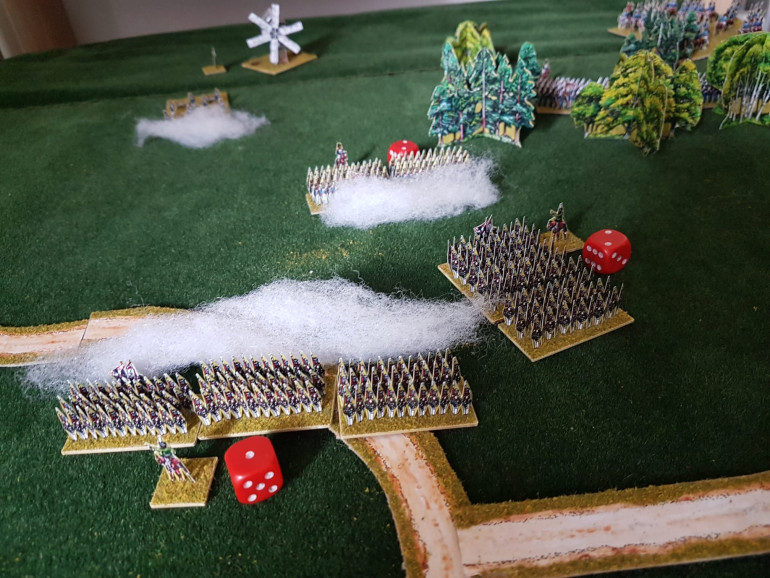 While the 3rd Line infantry changed to attack column, the 2nd Line advanced and fired a volley, trying to put pressure on the French.
While the 3rd Line infantry changed to attack column, the 2nd Line advanced and fired a volley, trying to put pressure on the French.Thoughts
- Wow, charging cavalry into a square formation is truly a bad idea! The defender gets to shoot with all bases AND gets a save, which is a 2+ at 3 to 4 bases remaining!
- Then I was wondering whether you are allowed to shoot into close combat, since the rules mention nothing explicitly concerning this. I’ve mostly done so, since I interpret any shooting as happening just before or after a charge. Also, close combat always ends with one side moving away, so I tend to imagine that somewhere around the close combat fighting a volley is fired into the enemy. Interestingly, the rules do specifically allow shooting before or after a move (even though the shooting phase comes after the movement fase, so I’m not sure how that is supposed to go exactly). So there are clues, but no hard facts.
Battle report: The Battle of Derevushka, round 6
While the French chasseurs occupied the opposing cuirassiers, the battered French 1st Line infantry and Guard made their way for the Russian command and supply base. The voltigeurs advanced towards the Russian flank and fired an ineffective salvo at the Russian artillery.
The French 2nd Line slowly retreated, while firing at the Russians. Meanwhile the Poles reformed in the cover of the woods and prepared to assault the opposing attack columns. With the Russian 2nd Line infantry coming closer, they were finally in range for the French artillery’s cannister shot. Unfortunately for the French, they inflicted only minor wounds.
With the Russian Northern line overrun, the cuirassiers scrambled to protect the supply lines and charged into the French chasseurs à cheval. Bloody battle ensued, with the cuirassiers pushing the French back and causing some of them to flee. Meanwhile the repositioned Russian artillery opened fire on the Imperial Guard, wounding them, but not enough to stop the Emperor’s finest in their tracks.
At the same time, the ever so patient Russian 3rd Line infantry was finally able to charge into the French line, cutting down the already weakened French 2nd. The Russian 2nd Line infantry made an about turn not only to guard against possible attacks from the rear, but also to move away from the French artillery, and to continue guarding their own artillery.
Thoughts
- I found out that only light infantry has no movement penalty in woods… Oops! This means that units of line infantry will have to halve their movement value inside the woods.
- If you’re wondering by now why the chasseurs à cheval haven’t charged the Russian artillery: artillery cannot be charged as long as there is a unit of line infantry within 8 cm of the artillery.
- With the advance of the French North, we might see the rule play out where for each line infantry or horde that reaches the opponent’s table edge, the opposing player has to remove two units. The unit itself is also removed! This symbolises them wreaking havoc upon the supply lines and command centre.
- For the Russian side I was planning to use the cossacks to run down the French artillery. Unfortunately, I found out that tribal cavalry is not allowed to charge anyone ever.
Battle report: The Battle of Derevushka, round 7
The chasseurs did another strafing run on the Russian cuirassiers, peppering them with carbine fire. While this did not cause any significant casualties, it did allow the Imperial Guard and 1st Line infantry to continue towards the Russian command positions behind enemy lines.
The voltigeurs took the opportunity to lay down fire on the flanks of the Russian 2nd Line infantry, who were clearly taken by surprise. They lost one base to fire and another to failing morale.
The French artillery, that made Europe tremble in its boots, rained down death on the Russian 3rd Line infantry, which took such heavy casualties that the remainder dispersed in utter panic.
With the French line infantry inching towards their supply lines, the Russians made a desperate attempt to stop them. Russian cannon fired a mighty volley of cannister into the French Grenadiers, almost wiping them off the map. The Grenadiers stood their ground, however!
The remnants of the Russian 2nd line infantry returned desperate fire to the voltigeurs, but were not able to hit any of the skirmishers. The cossacks loosed a strafing run of carbine on the Polish, who had reformed to attack columns, but for all their brouhaha, managed to hit nothing.
The cuirassiers charged into the chasseurs, hacking into them and chasing them into the line infantry behind them, causing the remainder of the light cavalry to disperse.
Battle report: The Battle of Derevushka, the End
This was a double post for “Battle report: The Battle of Derevushka, the End”. Thank you for liking it!
Battle report: The Battle of Derevushka, the End
Badly wounded, the Imperial Guard and 2nd Line limped towards the edge, which was just within reach! The voltigeurs attempted to distract the Russian cuirassiers and hasitly fired at them. This caused some casualties, but not enough to stop them. The French cannon, attempting to support their allies, took a shot at the Russian 2nd line infantry, but found it difficult to hit them.
Meanwhile, the Polish satellite infantry and the 2nd cossacks fought a skirmish of their own. The Polish deployed to line and fired upon the elusive cossacks, wounding some. The cossacks, in turn, returned ineffective carbine fire, which seemed to annoy them at most…
After defeating the chasseurs à cheval, who had held their ground so valiantly, the Russian cuirassiers were finally able to charge french 1st Line infantry. The stood no chance and were wiped out, but not without taking some of the heavy cavalrymen with them!
This meant that only the Grenadiers needed to be stopped and the Russian artillery let loose a barrage to do just that. Be it tenacity, be it luck, the Grenadiers kept marching.
Thus, as a first move in the next round, the Imperial Guard reached the table edge (read: Russian supply lines and command centre), which meant that the Russian side had to remove two units, bringing them down to two remaining units, and thus concluding the bloody Battle of Derevushka. Officially the French won the battle, but with only three units remaining themselves, you ask yourself at what cost. If history had paid attention, they might have seen this as a forshadowing of the brutal Battle of Borodino.
Afterthoughts
It seems a long time ago since I cut into that first strip of paper about half a year ago and now I have completed my first Napoleonic battle.
Could I have done it faster? Perhaps. It was the perfect hobby, however, for those small stolen moments in between family and work life. Cutting the units always gave a half an hour of meditative contemplation in the train to or from work. I didn’t need much hobby space to lay out paints and miniatures. Just a pair of scissors and some strips of paper.
Gaming it
Then, once I’d finished the armies, I cleaned up the table next to my desk in my home office (I’m very much aware of this luxury!), and turned it into a Napoleonic battlefield. On Wednesdays during my break I’d then play a round, or perhaps in the evening when I was alone. This was slow, but fine. The ruleset was quite intuitive and required very little looking up, even with a week between each round.
This was the first time I did solo wargaming. I’d worried that I’d see through my own clever plans recursively, imploding the game into a singularity of disillusionment. Furtunately, I clearly didn’t know what I was doing, so there was little to see through. On a more serious note: I found out that I was very much able to focus for each side on what made sense for them and act accordingly. This may sound vague, but made sense and actually remained exciting. A part of me does wonder whether the game was so close because it was the same guy commanding each army…
The rules
This brings me to the ruleset. I’ve given allusions to and snippets of the rules here and there over the course of this project. I have no idea whether this was enlightening or confusing for you.
As I’ve mentioned before, the rules are easy and intuitive to understand. This allowed me to play a round with almost no interruptions from leafing through the rulebook. I really like that the army lists require you to pick a minimum of certain units, making sure that the armies do not consist of four units of artillery with four units of cuirassiers, but actually reflect the period. I was skeptical of the fact that every army gets eight units (or six if you’re playing an old style army during the revolutionary period), since I was worried about how you’d reflect the inbalance between opposing armies, which supposedly defines most of historical wargaming. I found out during my first game, however, that the obligatory unit choices do reflect some of the imbalance, albeit not in size. The cossacks were fast, but seemed useless at times (although this may be more due to my being inexperienced as a Napoleonic commander). Another example is that the Grande Armée army list has to include a unit of satellite line infantry, which has worse moral than their regular French counterparts in this ruleset.
I can imagine that certain choices in the rules will frustrate some (especially veteran?) players, like that cossacks cannot charge anyone ever. I do not know enough of the period to draw any firm conclusions on these. What I do know, however, is that the game was fast and fun.
One thing where I can comment on the brevity of the rules, however, is that some examples would have been nice. There is a battle report at the end of the book, but it does not go into the technicalities of the rules. As such, I haven’t been able to find out what Neil Thomas meant by:
“Any remaining wounds are carried over to the next combat.”
It took four wounds to remove a base, but did he mean that if you scored three wounds, they were only carried over to the next and discarded afterwards? Or did this mean that you should just track the number of wounds until you can remove a base? I went with the latter.
Also, after the close combat phase, the losing side is supposed to retreat in a straight line backwards, either half a move while facing the enemy, or a full move facing away from the enemy. When they run into another unit while retreating, the retreating unit is removed from battle. But he didn’t mention anything about table edges. I can imagine that a table edge would also remove a retreating unit, but I felt this was too severe in my case, where the table was relatively small. I therefore allowed a retreating unit to retreat along the edge. This led to an advantageous retreat here and there, but in the end I think it did allow for a more interesting game on the flanks. All in all, the brevity was not game stopping and could be solved with some common sense and imagination.
Can I recommend Napoleonic Wargaming by Neil Thomas? If you, like me, haven’t played any Napoleonics before, I think this book is perfect for you. It gives you some history, an overview of tactics used and a quick ruleset to play your first games. If you’re a veteran player, I honestly don’t know. I’m curious to hear your thoughts!





























![TerrainFest 2024 Begins! Build Terrain With OnTableTop & Win A £300 Prize! [Extended!]](https://images.beastsofwar.com/2024/10/TerrainFEST-2024-Social-Media-Post-Square-225-127.jpg)

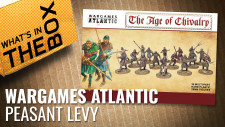
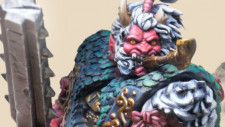


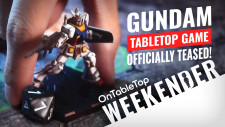






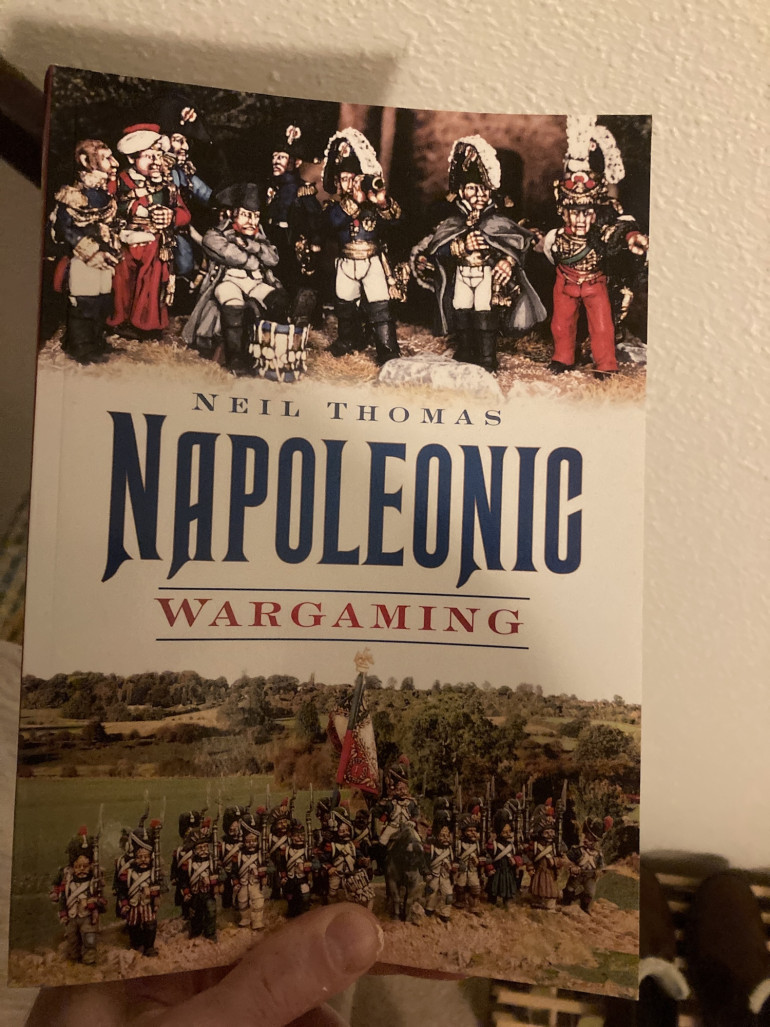
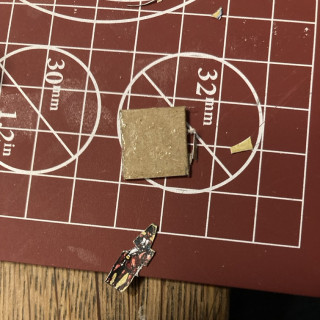
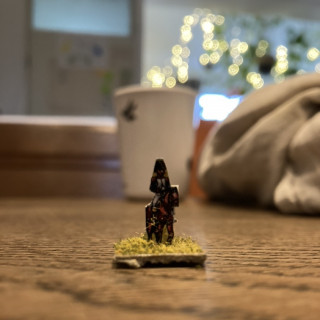
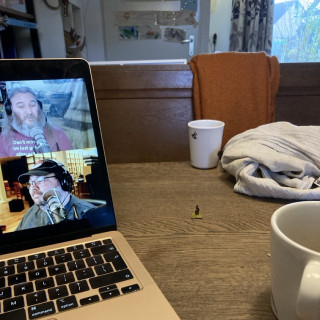
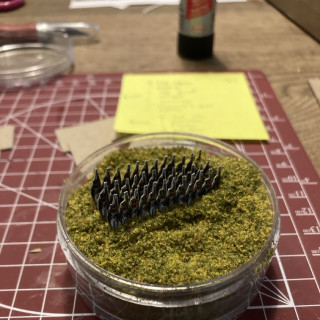
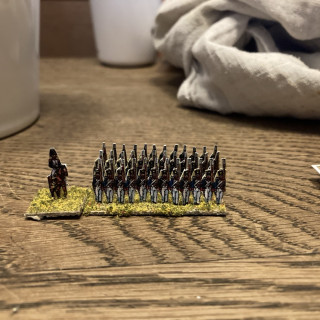
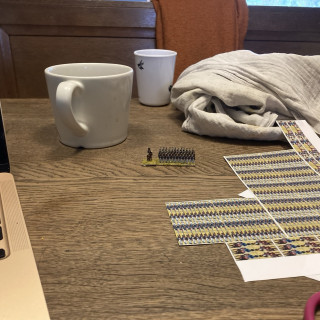
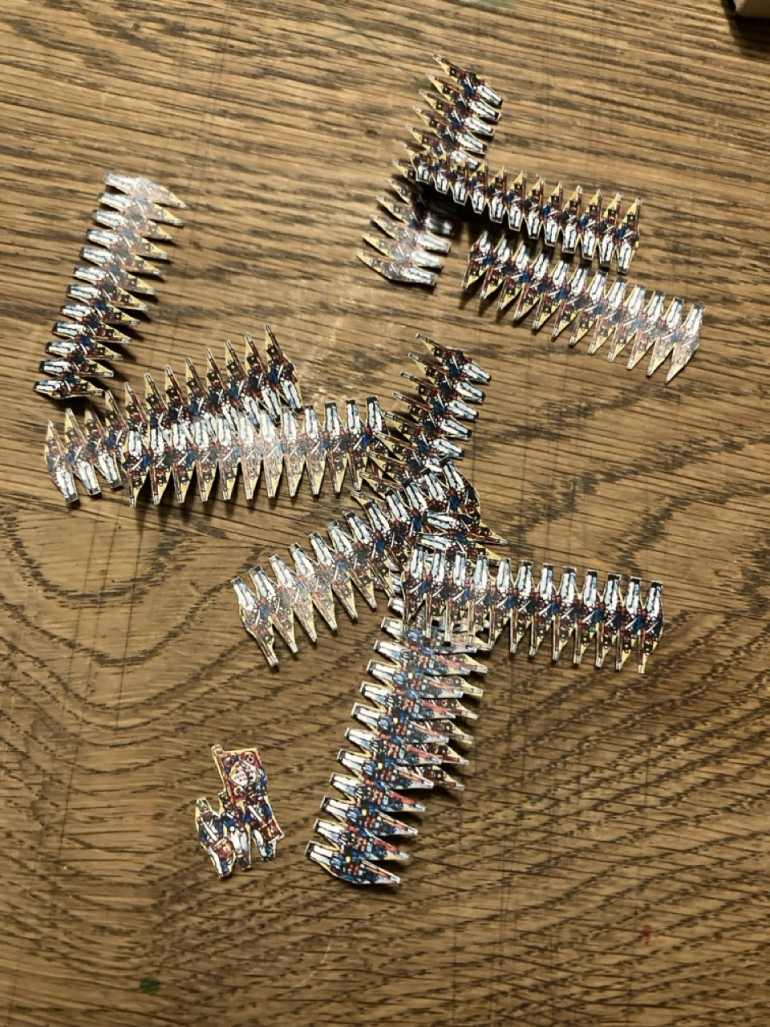
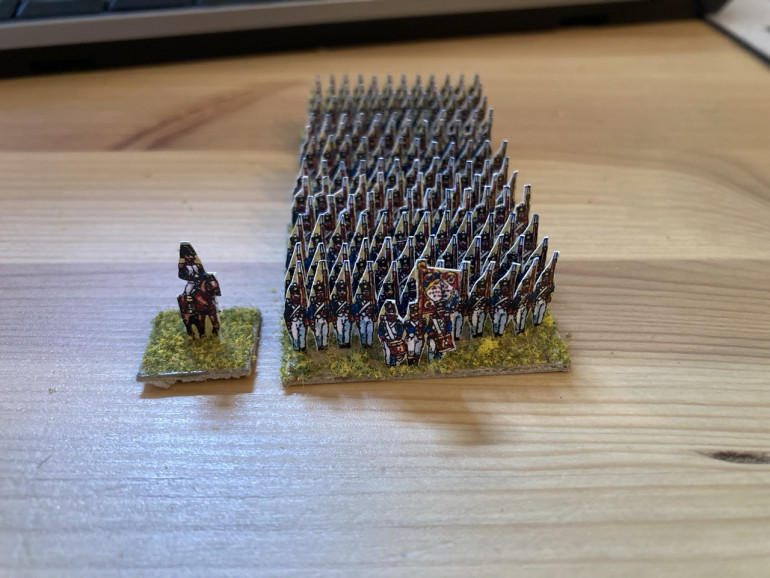
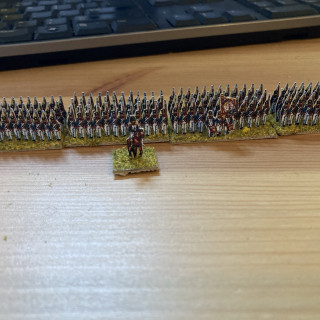
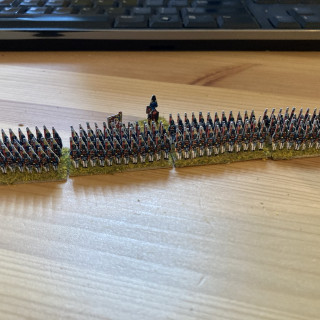

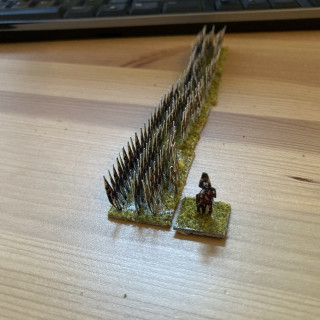
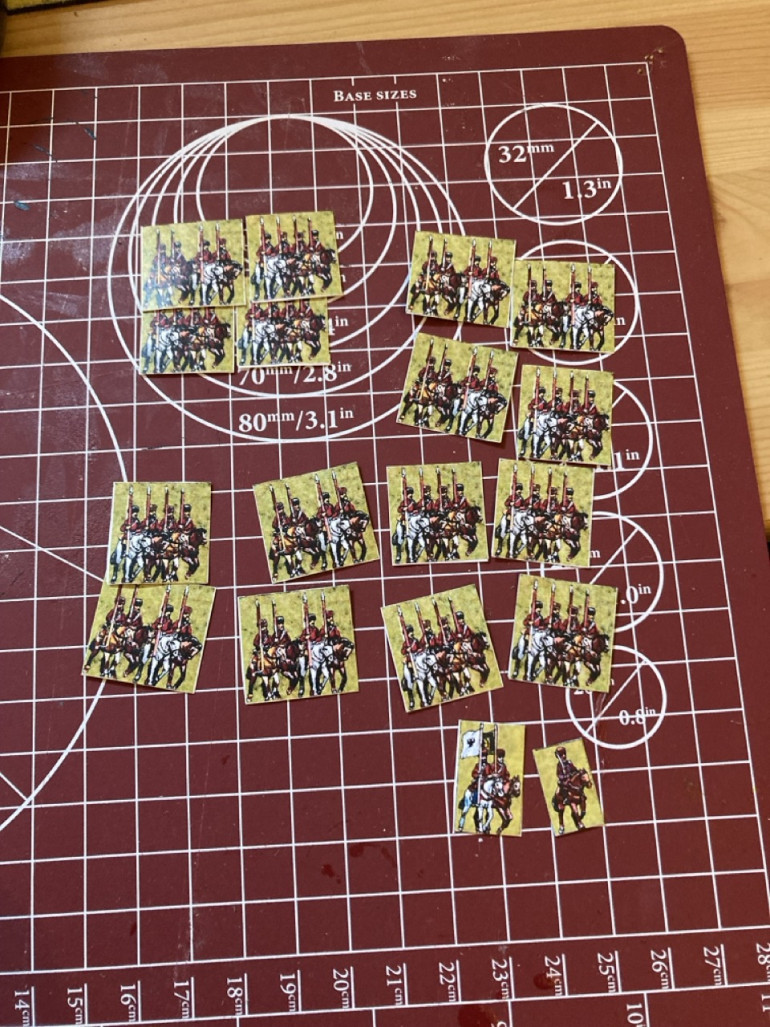
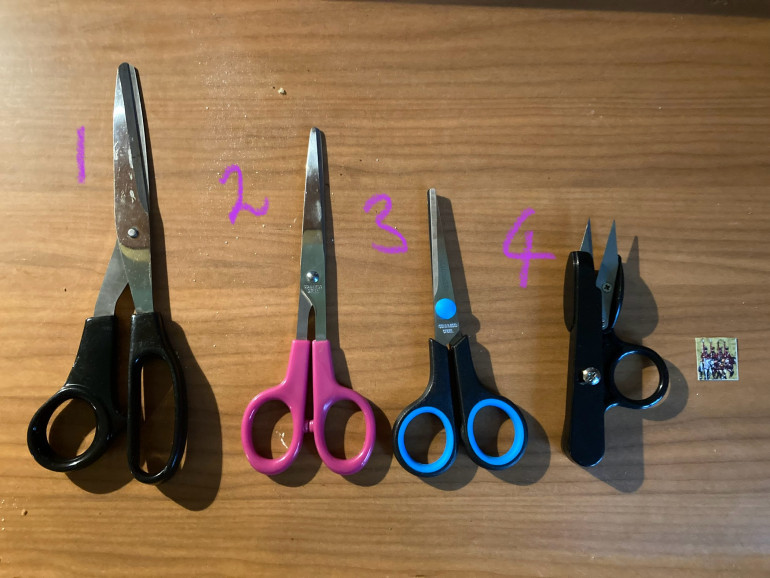
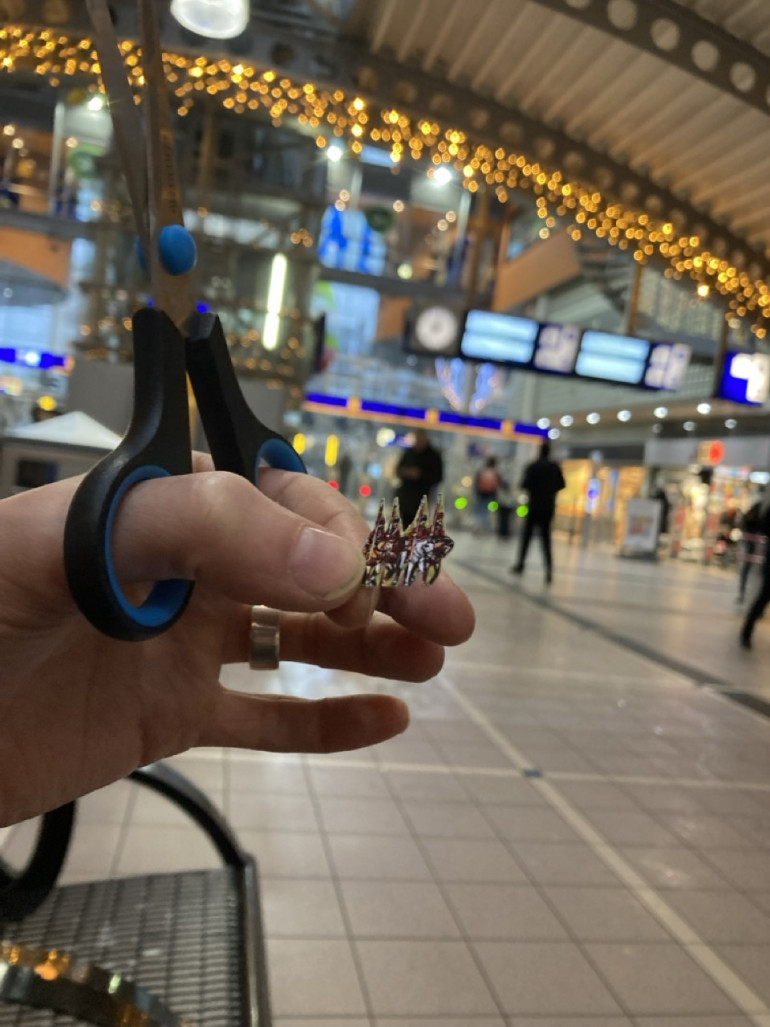
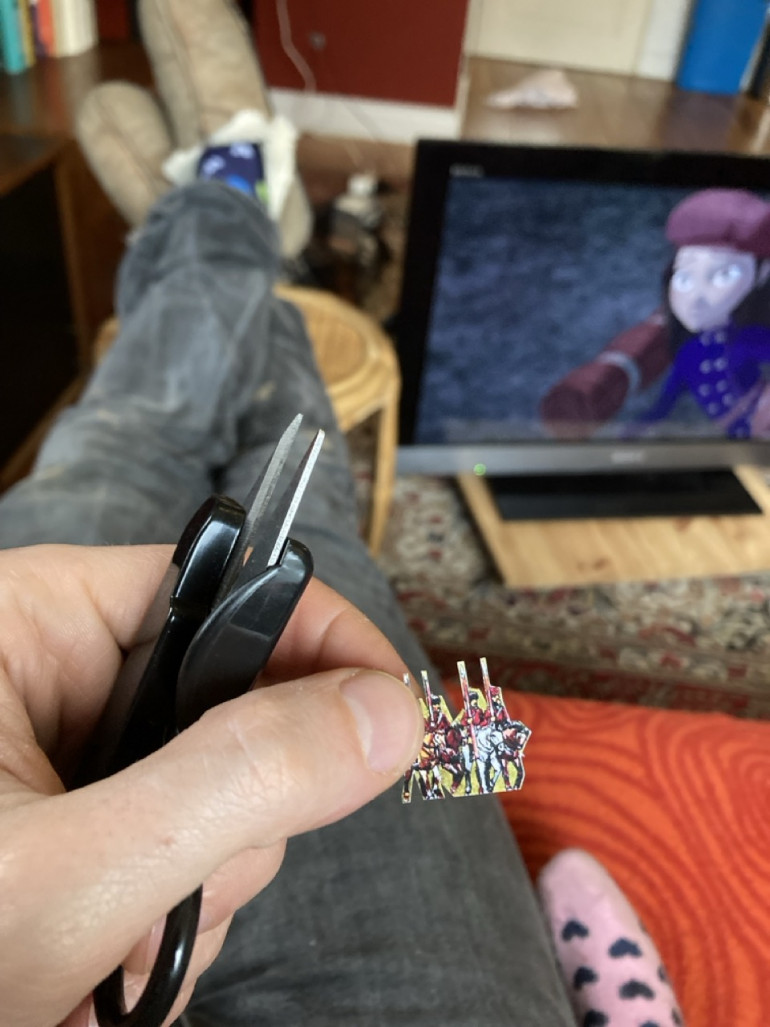
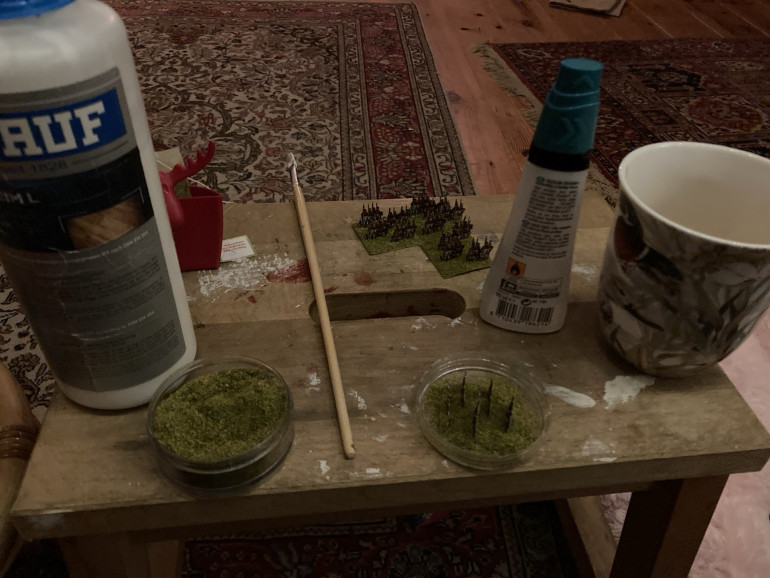
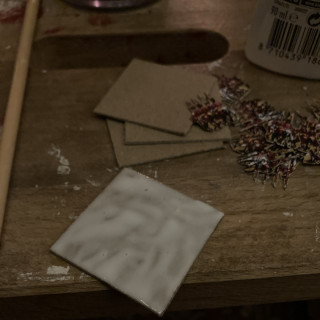
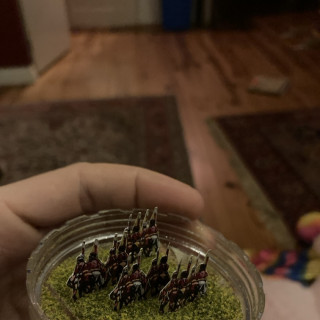
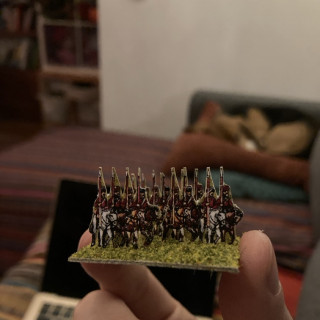
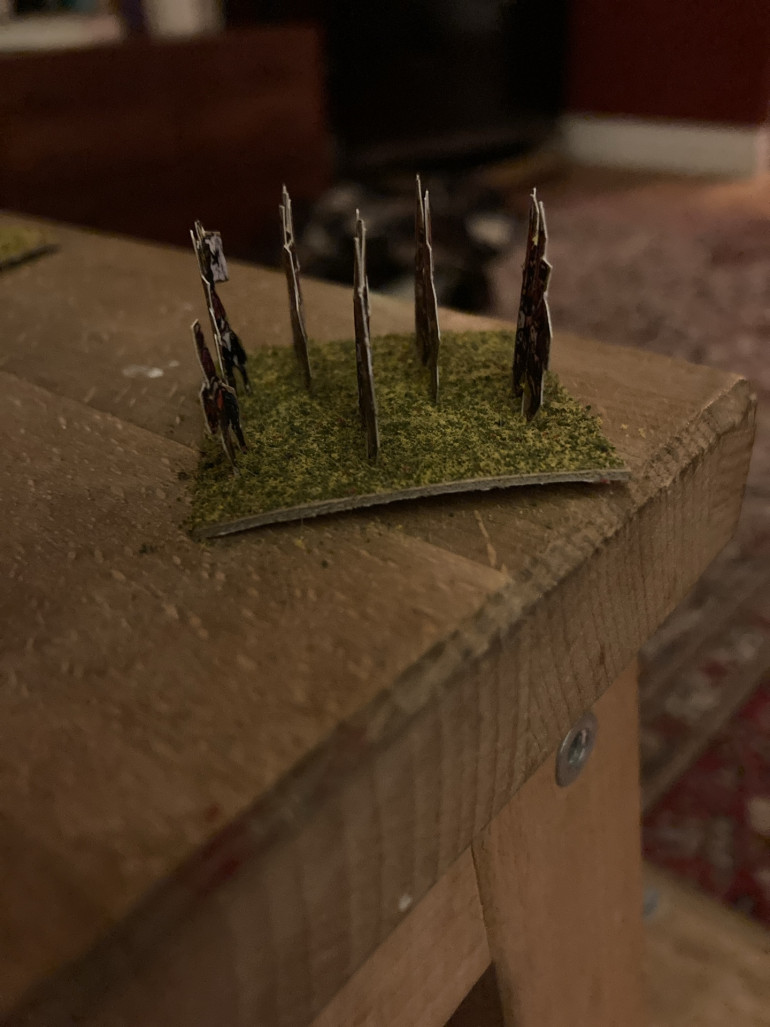
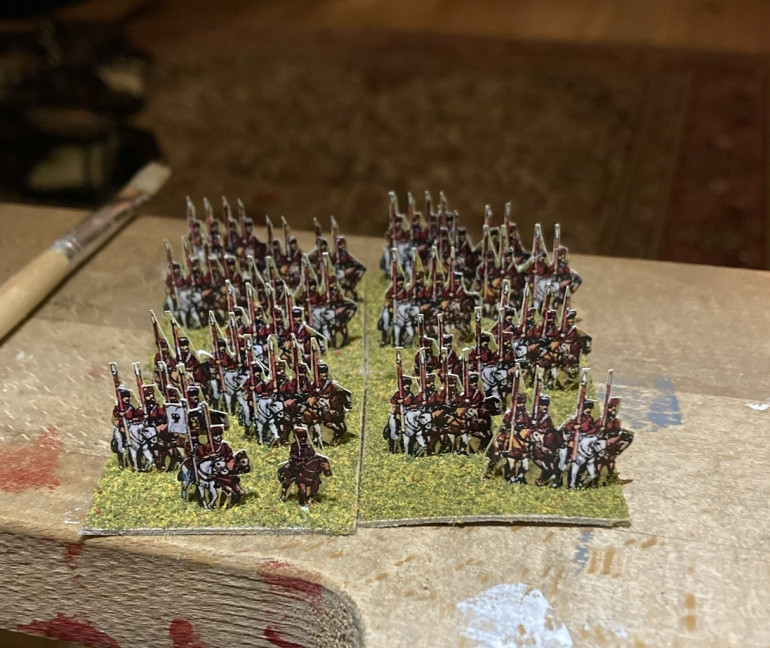
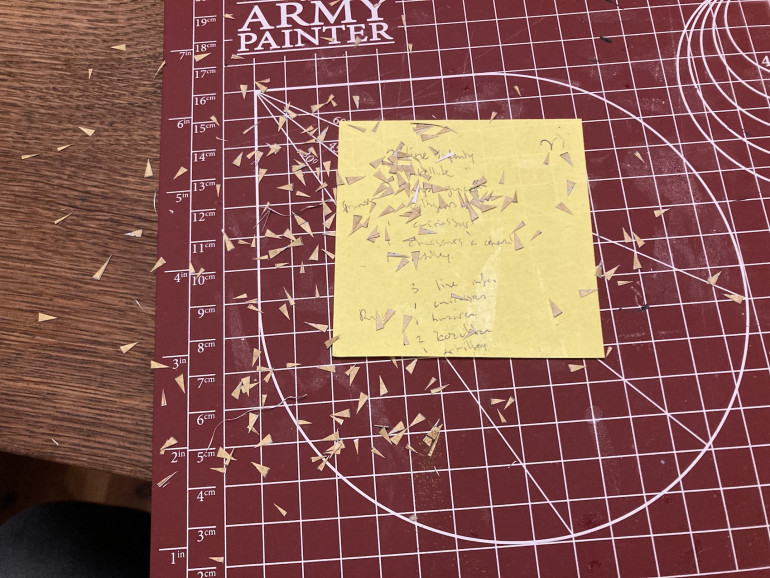
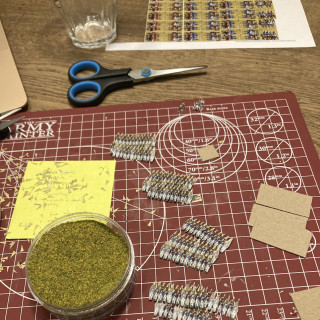
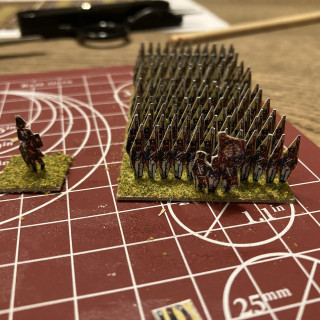
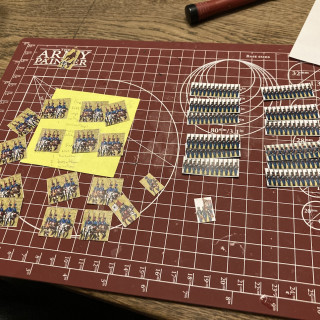
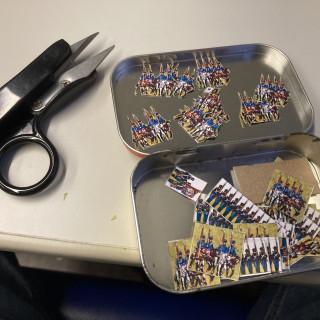
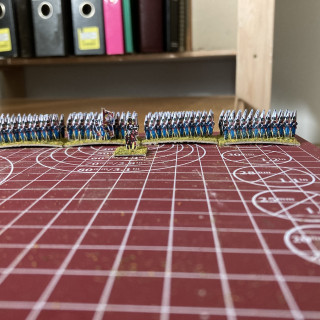
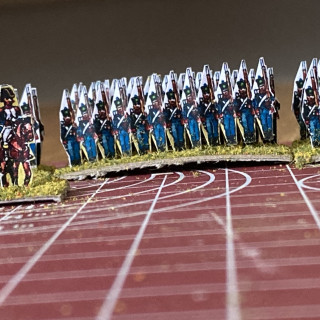
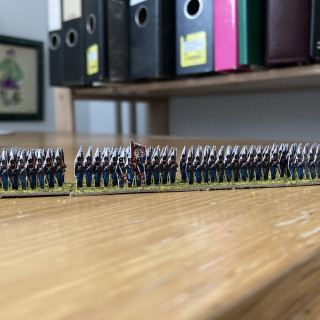
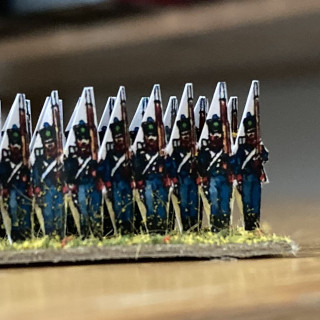

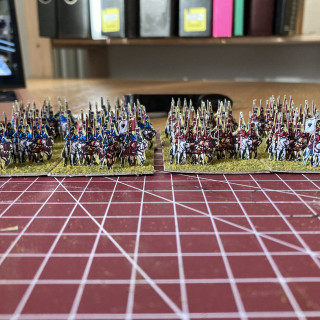
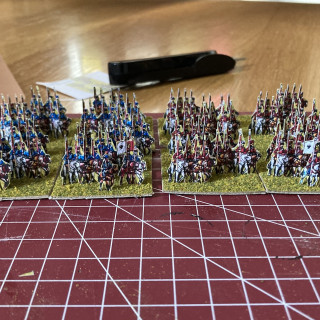
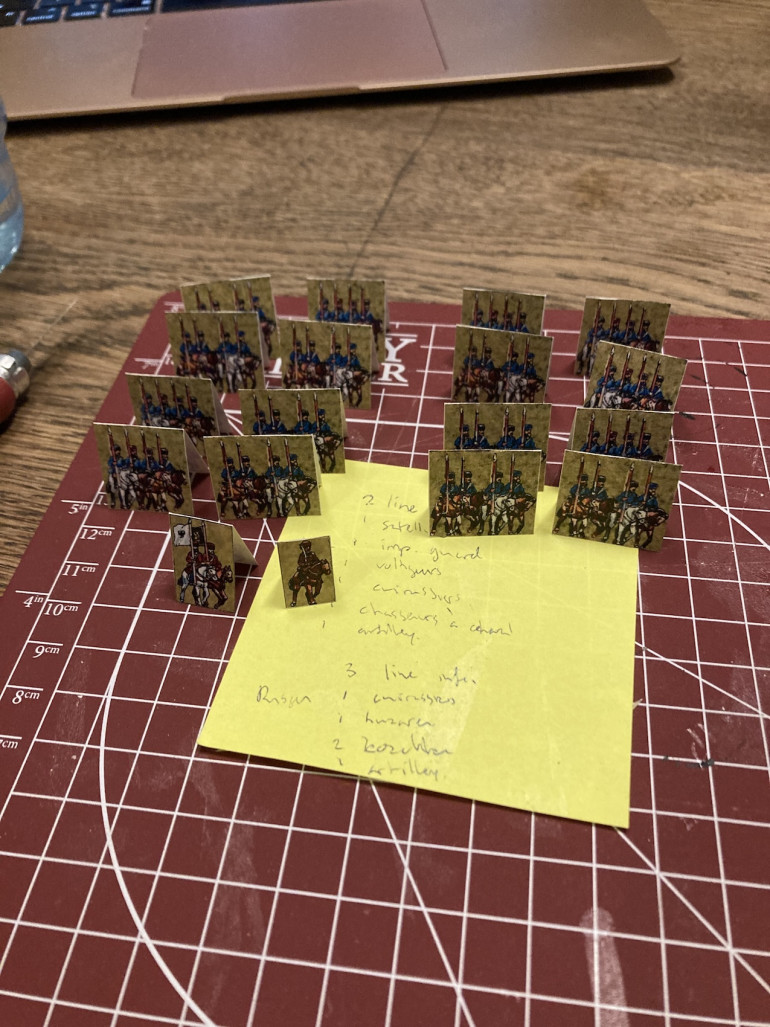

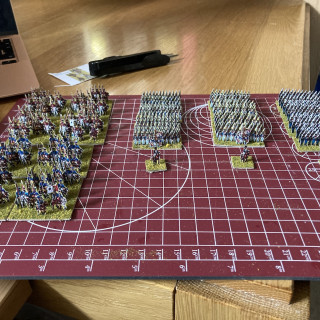
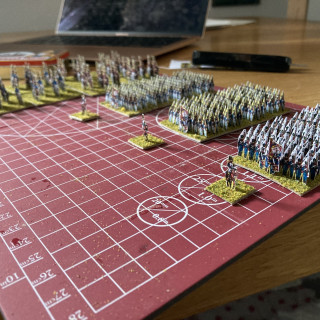
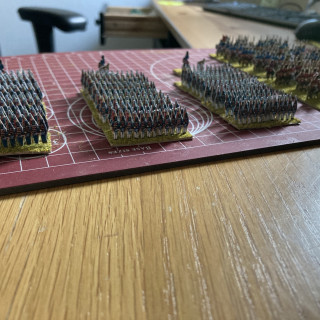
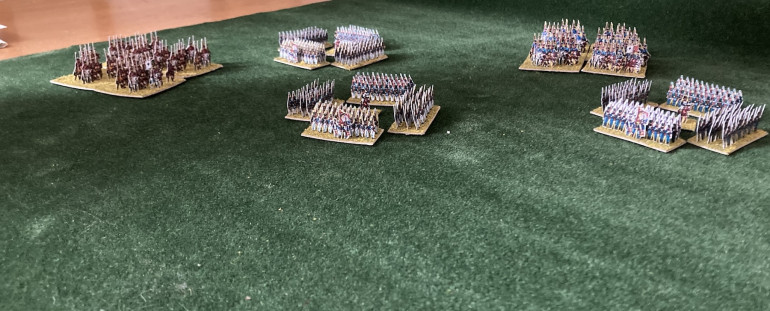
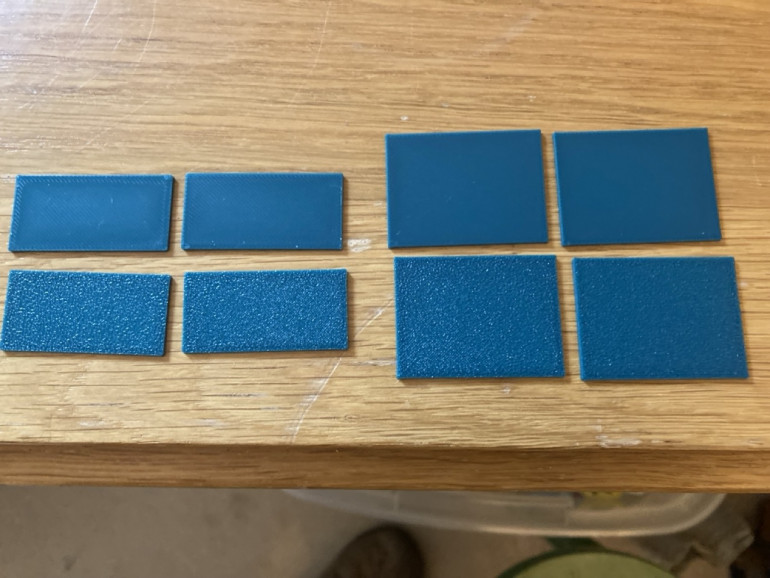
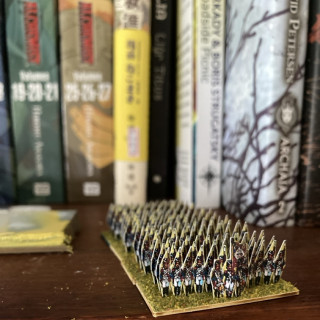
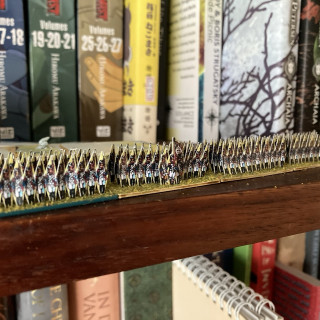

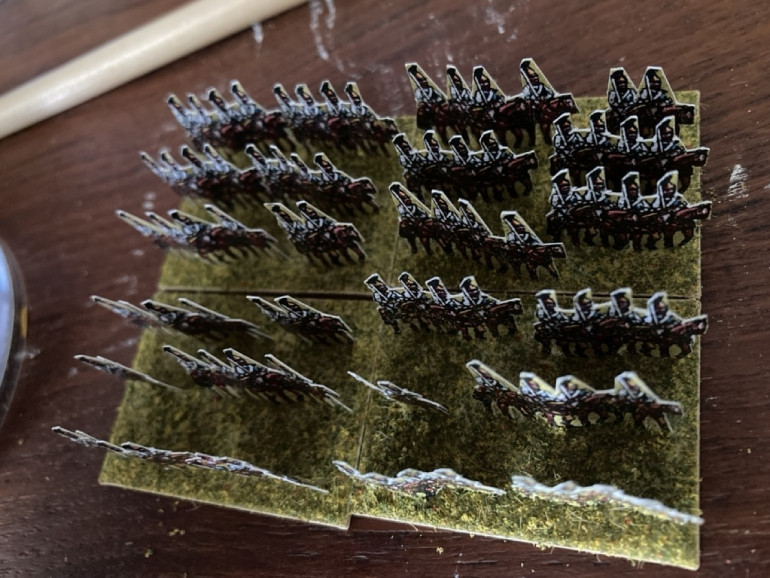
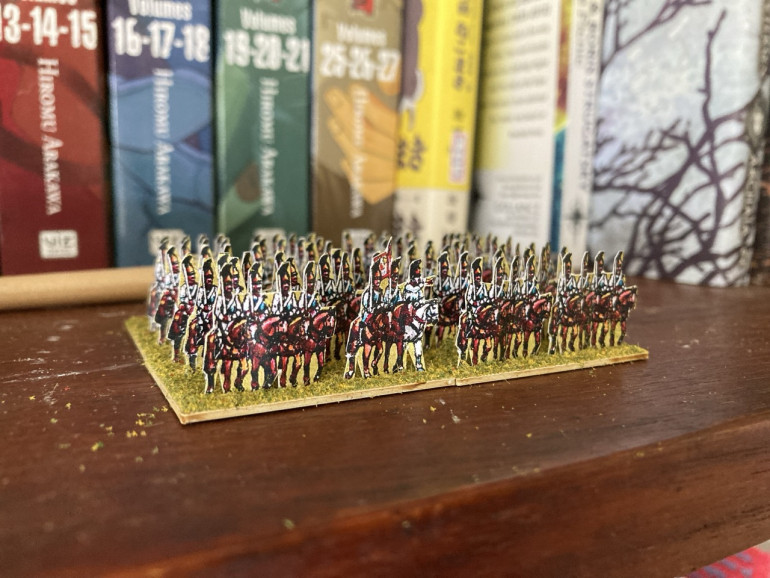
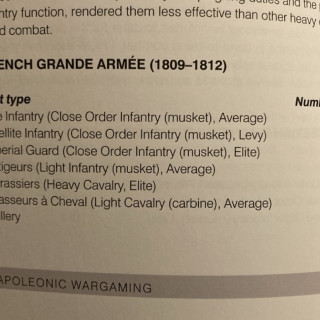
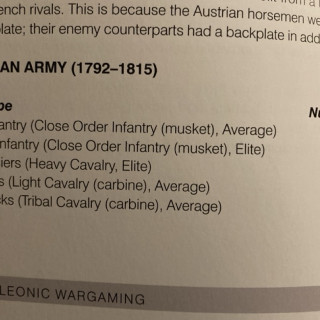
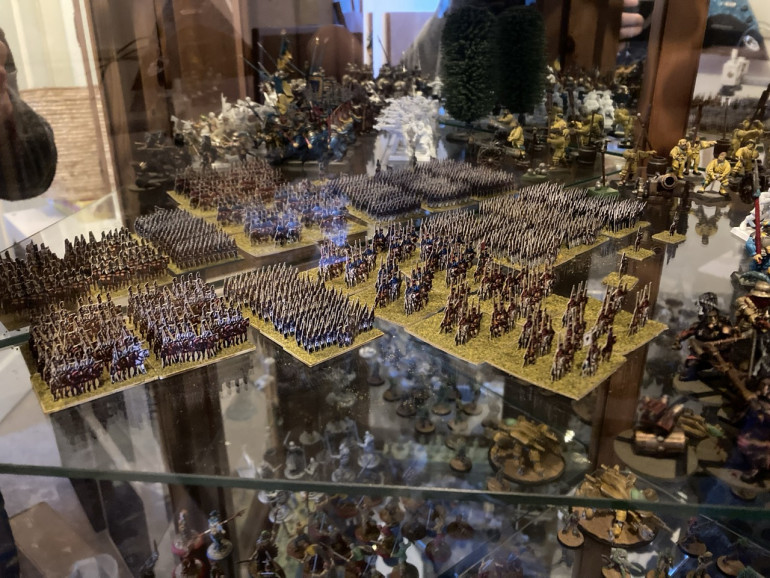
![The cannon are [sic]!](https://images.beastsofwar.com/2024/04/63291766-tip-770.jpeg)
![The cannon are [sic]!](https://images.beastsofwar.com/2024/04/16004900-cannon-design-320-320.jpg)
![The cannon are [sic]!](https://images.beastsofwar.com/2024/04/48289506-tiny-cannon-parts-320-320.jpeg)
![The cannon are [sic]!](https://images.beastsofwar.com/2024/04/47130289-tiny-cannon-assembled-320-320.jpeg)
![The cannon are [sic]!](https://images.beastsofwar.com/2024/04/75817868-tiny-cannon-four-320-320.jpeg)
![The cannon are [sic]!](https://images.beastsofwar.com/2024/04/62993298-tiny-cannon-vs-tank-320-320.jpeg)
![The cannon are [sic]!](https://images.beastsofwar.com/2024/04/77248897-research1-320-320.jpg)
![The cannon are [sic]!](https://images.beastsofwar.com/2024/04/76718812-research2-320-320.jpeg)
![The cannon are [sic]!](https://images.beastsofwar.com/2024/04/85087725-limbers-design-320-320.jpg)
![The cannon are [sic]!](https://images.beastsofwar.com/2024/04/88253438-tiny-limbers-assembled-320-320.jpeg)
![The cannon are [sic]!](https://images.beastsofwar.com/2024/04/21140877-limbers-and-cannon-320-320.jpeg)
![The cannon are [sic]!](https://images.beastsofwar.com/2024/04/99903599-cannon-done-1-320-320.jpeg)
![The cannon are [sic]!](https://images.beastsofwar.com/2024/04/65261318-cannon-done-2-320-320.jpeg)
![The cannon are [sic]!](https://images.beastsofwar.com/2024/04/66035317-cannon-done-3-320-320.jpeg)
![The cannon are [sic]!](https://images.beastsofwar.com/2024/04/38055287-cannon-done-4-320-320.jpeg)
